La Falsa Conciencia y la Trampa Kafkiana
Conferencia Nº 9
“[…] no debe importarte si es Critias o Sócrates el que es refutado. Preocúpate, pues, sólo de poner atención al discurso y de ver por dónde salir airosamente cuando se te cierre el paso con argumentos.”
-Sócrates de Atenas
En este punto es necesario dejar de lado el hilo conductor que he estado tejiendo, y desviarme dentro esa profunda jungla que es la lógica feminista. La frase lógica feminista puede parecerle a algunos lectores un nombre poco apropiado – ¡incluso un oxímoron! – así que déjenme aclarar que lo que en realidad quiero decir es tentativa feminista de lógica. Y no tiene nada de lógica, ¡se los aseguro!
En primer lugar ¿por qué les resulta tan amenazador el uso de la lógica a las feministas? Y definitivamente sabemos que lo es –con algunas feministas diciendo que la lógica no es más que una herramienta del patriarcado. Desde luego, eso es absurdo. Un argumento lógico es, por definición, una colección de inferencias válidas – de tal manera que no es posible discutir con la lógica. Para ponerlo de otro modo, no se puede razonar contra el razonamiento, porque el intento mismo implica el uso (tentativo) de la razón. La única manera de atacar la lógica sin usar (o sin intentar usar) lógica sería hacerlo de manera aleatoria –es decir, sin una consecuencia lógica. Los puntos argumentativos que se hagan, al atacar la lógica, no deberían tener ninguna relación entre ellos en lo absoluto. Por ejemplo, no podríamos decir:
Los hombres usan la lógica para derrotar a las mujeres, por lo que la lógica es una herramienta del patriarcado
debido a que el uso de “por lo que” indica una consecuencia lógica, ¡que es un asunto que pertenece al dominio de la lógica! Esto le deja a la feminista dos opciones poco favorables: decir que la lógica es una herramienta del patriarcado, sin hacer referencia a ninguna premisa, evidencia, ejemplo, definición, etcétera –sin ninguna referencia a la realidad; o aceptar que su propio argumento, que intenta relacionar dos proposiciones sobre una base lógica, es él mismo una herramienta del patriarcado –y como defensora de dicho argumento, ¡ella también lo es!
Por consiguiente, la respuesta apropiada al argumento feminista según el cual “no se puede confiar en la lógica porque es una herramienta del patriarcado,” es decir: “¡Usted también lo es! Hey, –como patriarca, ¡le agradezco que haga mi trabajo por mí!”
Pero una vez más, ¿por qué resulta tan amenazante la lógica para las feministas? ¿Podría ser porque están equivocadas respecto a la naturaleza de la lógica? Lo dudo. Después de haber visto feministas derrotadas por la lógica muchas veces, estoy seguro de que le temen porque sus creencias no soportan el escrutinio lógico. Como cualquier culto, el feminismo no permite a sus miembros indagar la verdad, ni tampoco tolera una discusión abierta y honesta sobre sus valores fundamentales. Sin embargo, nada de esto nos importa a nosotros –como no-feministas, no existe autoridad humana que nos obligue o que fuerce nuestro pensamiento o nuestra voz en lo que respecta al feminismo.
Si, las feministas le temen a la lógica porque esta contradice otras maneras de “conocer el mundo” –por ejemplo, que nos digan qué pensar. También temen que la lógica desacredite “verdades” ideológicas. Las feministas quieren que usted vea el mundo como ellas dicen que debería verlo –sin duda, ¡no quieren que usted llegue a sus propias conclusiones! En particular, que no llegue a conclusiones que sean críticas de la ortodoxia feminista, y que resulten del proceso de hacer preguntas y recibir respuestas insatisfactorias. No obstante, este es precisamente el producto que las feministas garantizan, cuando su ansiedad respecto al criticismo y a las consecuencias de una discusión abierta las hace reaccionar con exabruptos y con tácticas cuyo objetivo es avergonzar.
¿Qué pensaría un observador neutral y perspicaz cuando escucha que una pregunta razonable es respondida con un ataque contra el carácter del interlocutor? ¿Acaso esto lo inspiraría a adoptar la doctrina del conjunto de creencias en cuestión? ¿Qué es más probable: que se sienta amenazado hasta la sumisión por las tácticas humillantes usadas contra el buscapleitos, o que se sienta indirectamente ofendido por las evasivas del ideólogo y sus modales despectivos?
Los ideólogos no tienden a hacerse preguntas escrutadoras como estas. No es de sorprenderse entonces que la palabra ideología haya comenzado como un concepto de abuso. No fue sino hasta que Marx y Engels escribieron La Ideología Alemana que la frase tomó la caracterización con la que asociamos hoy en día la política de identidad. La ideología de cada persona, según dicen los dos autores, es el producto de la posición social de cada uno – es decir, si una persona hace parte del proletariado o de la burguesía. El proletariado socialista es quien posee la ideología que refleja la verdad, mientras que la burguesía capitalista solo posee una “falsa conciencia”. Nunca se explica cómo se sabe que las cosas llegaron a ser de esta manera y no al contrario –es decir, ¿Por qué no puede la burguesía capitalista estar en posesión de la verdad, y el proletariado socialista estar sometido a una falsa conciencia? No hay necesidad de responder esa pregunta ya que el Marxismo es un sistema de pensamiento cerrado. Es como un hombre que no está parado sobre el suelo sino, de alguna manera, sobre sus propios pies; cualquier parte del Marxismo se apoya en otras partes de la teoría, y para sustentarse no necesita de los caprichos del mundo experiencial. En otras palabras, lo que sucede en el mundo real no importa – el Marxismo se verifica a sí mismo. La verdad que apoya sus afirmaciones se encuentra dentro de la misma teoría, completamente independiente de cualquier evidencia contraria que pueda ser recolectada de las experiencias reales de gente real.
En ese sentido, es muy parecido al feminismo –en tanto éste también es abstracto y anti-contextual, decidiendo sobre la historia antes de que se conozcan los hechos. El feminismo, para las feministas, no requiere justificación fuera de sí mismo. No puede ser penetrado por ningún argumento externo, y por lo tanto es irrefutable –debido a que es irrazonable, es decir: no se puede razonar con él. Es una pérdida de tiempo tratar de lograr que las feministas sean sensatas, y cualquier MRA [Defensor de los Derechos del Hombre] aprende rápidamente que sería más fácil exprimir sangre de una piedra. El único discurso que conseguiría que las feministas se sentaran y cambiaran su manera de ser es el discurso de poder: y este discurso necesita apoyarse en actos. Los Anti-feministas deben sentirse cómodos con la idea de ejercer poder sobre las feministas, al menos hasta marginarlas y volverlas irrelevantes. Este es el objetivo final. Alcanzar el punto de masa crítica es la manera en que llegaremos allá, pero retrocedemos cada vez que les permitimos a las feministas darse gusto en su sofistería.
Tomemos, por ejemplo, el sofisma feminista según el cual estamos “encerrados” dentro de una perspectiva determinada por el sexo al que pertenecemos. Cualquier argumento contra-feminista esgrimido por un hombre, no importa qué tan exactas sean sus observaciones, no importa cuánta evidencia haya detrás de sus afirmaciones, puede ser desechado aduciendo que lo dijo un hombre. La razón es algo así: “Usted sólo está diciendo eso porque usted es un hombre. Si no fuera hombre, no tendría una perspectiva masculina, y por lo tanto no estaría diciendo eso.” La implicación es que la perspectiva masculina es inherentemente errónea –que un hombre, debido a que es un hombre, no es capaz de captar la verdad. Ahí está, ese es realmente el mismo truco de la falsa conciencia practicado por Marx y Engels y sus seguidores –la feminista no ha explicado porqué o cómo a perspectiva femenina, debido a que proviene de una mujer, es necesariamente la única que puede captar la verdad.
El truco de la “falsa conciencia” es, en últimas, una evasión. En una movida poco honorable, la feminista ha esquivado el argumento mismo y ha atacado al interlocutor. –“usted no puede tener la razón, porque usted es hombre.” Para la feminista, esto es suficiente, considera el asunto finiquitado, y continúa su camino. Por el mismo razonamiento oculto gracias al cual Marx sabía que el proletariado poseía la verdad, la feminista “sabe” (en otras palabras, tiene la fuerte impresión) que su ideología está en posesión de la verdad. Pero ese razonamiento oculto, cualquiera que sea, no funciona a la inversa. La feminista está segura de que un contraargumento que use la misma táctica –“usted no estaría diciendo eso sino fuera una mujer”– no es aplicable ni posible. La implicación es que las mujeres feministas ven el mundo objetivamente, mientras que los hombres están “encerrados” en su perspectiva privilegiada y no pueden ver las cosas como en realidad son. Un ataque a la perspectiva de un hombre, debido a que es una perspectiva masculina –aún el identificar una perspectiva como peculiarmente “masculina”– no es más que una afirmación de supremacía femenina.
En cuanto a las mujeres no-feministas, ellas también son oprimidas por la “falsa conciencia”, pues cuando las mujeres toman sus propias decisiones ¡están siendo manipuladas por el patriarcado! Pero cuando dejan de pensar por sí mismas, y se acogen a la autoridad de la conciencia feminista sin cuestionar nada, ¡es entonces cuando sus mentes han sido liberadas! ¿Pueden ver cómo es que funciona la cosa?
Ahora, detesto arruinarles la diversión al ser un hombre que dice cosas que no diría si no fuera un hombre, pero hay algo en todo esto que no tiene sentido. Lo que las feministas están tratando de impartir es un tipo de determinismo sexual, es decir, la noción que están tratando de propagar es una que dice que nuestras acciones y comportamientos están determinados por nuestro sexo, y que no tenemos ningún tipo de libertad de elección en el asunto. Somos robots morales, programados desde el nacimiento para ver el mundo de una manera particular, de la que no nos podemos desviar.
Esta teoría solo tendría algún significado si pudiera decirnos cómo hombres y mujeres actúan y piensan. No obstante, tanto hombres como mujeres son mucho menos predecibles de lo que aquellos obsesionados con encasillarlos quieren que sean. Hay, por ejemplo, feministas que son hombres, MRAs que son mujeres, y gente de ambos sexos que se rebelan en contra de todas las tendencias que podamos imaginar. El determinismo sexual feminista, por lo tanto, se ha vuelto una teoría inútil; si hay algo de verdad en ella, ésta se limita a aquellos aspectos del comportamiento humano que no pueden ser identificados. Se ha reducido al estado de tautología: ¡siempre haremos esas cosas que siempre hacemos!
Sobra decir que mujeres y hombres no somos dos grupos opuestos e internamente homogéneos. A las feministas les encantaría que así fuera. Sin duda, el feminismo descansa sobre esta percepción defectuosa. La idea de que los hombres y las mujeres deberían oponerse unos a otros es una construcción feminista, y cualquier desviación de esta premisa es una amenaza para toda la empresa feminista –de ahí el imperativo de la destrucción familiar. Esta también es la razón por la cual los ataques más venenosos se reservan para los “aliados feministas” hombres. Ese pequeño número de hombres que ejercen la auto-disciplina más estricta de acuerdo a la ortodoxia feminista son los que sufren las arremetidas más violentas por no ser lo suficientemente feministas. Lo anterior sucede porque cada hombre que se considera en lo más mínimo pro-mujer es una espina en el costado del feminismo, tanto como la más declarada mujer anti-feminista (y quizás más aún: en el caso de los hombres feministas, no hay ningún equivalente del argumento de la “falsa conciencia” que sí puede ser usado contra las mujeres anti-feministas). ¡Se debe negar el hecho de que los hombres feministas pueden llegar a ser lo suficientemente feministas! Se debe mantener la ilusión de que los hombres son “el enemigo” –y esto quiere decir que hay que repudiar las intenciones amistosas de los aliados masculinos. Al declararse a sí mismos feministas, esos hombres van en contravía del determinismo sexual feminista, y por lo tanto están contradiciendo la teoría feminista y amenazando el progreso del todo el movimiento. No es tan fácil describirlos como unos salvajes atávicos, y esto se debe a sus esfuerzos por estar siempre dispuestos a obedecer –razón por la cual reciben semejante desprecio tan corrosivo.
Para volver a nuestro tema central, el Marxismo y el feminismo tienen más en común además del Recurrir a la Falsa Conciencia. Ambos se acomodan a un patrón con el que podemos dibujar un mapa de cualquier ideología radical moderna. De nuevo, son los progresos en lenguaje y pensamiento los que permiten que configuraciones teóricas den lugar a movimientos sociales como el feminismo. El socialismo solo fue posible cuando se pudo distinguir conceptualmente entre el estado y la economía –en la época feudal, no era posible discernir entre los dos, lo que hacía irrelevante la posibilidad de que un sistema socialista fuera idealizado. Fue como respuesta al surgir del capitalismo, con todo lo que ello implicaba –pensamiento Ilustrado, individualismo económico, libre comercio, libre trabajo, y el final de la posibilidad de vender los derechos de cobrar impuestos, la formación de negocios y de la clase trabajadora –que el socialismo Utópico y (después) el Marxismo se volvieron una posibilidad en el ámbito de la imaginación.
De manera similar, el nacionalismo -en su forma moderna, como ideología– solo fue posible una vez que se pudo distinguir entre sociedad y cultura tanto en el lenguaje como en el pensamiento. Nuestra pregunta aquí es ¿qué fue aquello que hubo necesidad de distinguir antes de que el feminismo se convirtiera en una posibilidad?
La anterior es una pregunta que requeriría de mucho espacio para ser respondida –más espacio del que tengo disponible aquí. Bastará decir que el cada vez mayor número de libertades que se le otorgan al hombre resultan en una divergencia de expectativas entre hombres y mujeres. No es de extrañar entonces que una pequeña cantidad de mujeres empezaran a preguntarse por qué la noción heredada de la Ilustración de la libertad individual debía extenderse exclusivamente a los hombres. Sin embargo, lo que a menudo se omite es que estas mujeres se encontraban en posiciones privilegiadas –eran las beneficiarias de códigos culturales Ginocéntricos que las ponían en altos pedestales, muy por encima de los hombres. Con el transcurso de las décadas siguientes, los hombres tropezaban al dar a las mujeres todo lo que estas pedían. Es probable que la mayoría de estos hombres creyeran sinceramente que la libertad individual debía extenderse a las mujeres así como se había hecho con los hombres, pero el hecho de que el Ginocentrismo ya se estuviera dando con fuerza significaba la supremacía femenina sería el único resultado posible del feminismo. La “igualdad” que las feministas buscaban era una “igualdad” para hacer todas las cosas que estaban permitidas para los hombres, y además conservar las ventajas tradicionales que las mujeres han tenido sobre los hombres, acumuladas a lo largo de siglos de Ginocentrismo. Las destinatarias de las ventajas tradicionales no eran, desde luego, iguales en lo absoluto, sino personas privilegiadas a expensas de todos los demás. Esa fue siempre la intención.
A pesar de las afirmaciones de las feministas según las cuales ellas están prescindiendo de todas las formas de pensamiento masculinas y creando otras nuevas, el feminismo cae en su justo lugar entre otras ideologías radicales que la precedieron (y que fueron, desde luego, concebidas por hombres). Tomemos el hecho más obvio de las ideologías radicales modernas, es decir el que sus fundamentos se encuentren en sus formas de asociación –los Marxistas ponen al proletariado en oposición a la burguesía, los nacionalistas ponen su propia cultura o raza en oposición a una sociedad cultural o racialmente diversa, y las feministas ponen a las mujeres en oposición a los hombres. Las relaciones esenciales, usadas por ideólogos como explicaciones absolutas para cualquier tipo de fenómeno humano, corresponden a las formas de asociación que son enfatizadas. Para Marx, la relación clave es económica –el control de los trabajadores por parte de los capitalistas es una relación económica, y todo lo demás (política, religión, cultura) no es más que una “superestructura” que se encuentra sobre esa “base”. La superestructura puede cambiar, pero nada fundamental puede ser alterado a menos de que la relación económica entre las clases se reconfigurada. De manera similar, para los nacionalistas, la relación esencial es cultural (o racial, si ambas se pueden diferenciar). Esta es la “base” sobre la que se construye todo lo demás. Cualquier cambio que se haga a las estructuras superficiales que se encuentran sobre la “base” (por ejemplo, modificaciones a instituciones políticas o sociales) es irrelevante; el único cambio fundamental llegará gracias a transformaciones en las características culturales o raciales de la población.
Es posible apreciar el mismo patrón en el feminismo. Poner en oposición a hombres y mujeres, que es la relación esencial según las feministas, es desde luego algo sexual. Es la relación de los hombres respecto a las mujeres la que determina todo lo demás (política, economía, religión, cultura, etcétera). Es posible que los elementos de la superestructura cambien, pero hasta que la dominación de las mujeres por parte de los hombres sea derrocada en el nivel básico, no se conseguirá nada fundamental.
Es esta creencia la que a final de cuentas explica la tentativa feminista de lógica. Sus intentos de argumentación racional están nublados por una creencia en la culpa colectiva – que todos los problemas o inconvenientes que las mujeres deben enfrentar son el resultado de esa relación básica (la dominación de las mujeres por parte de los hombres, por lo que, mientras persistan esos problemas e inconvenientes, debe ser porque los hombres (colectivamente) están dominando a las mujeres (colectivamente). No importa si un hombre en particular es inocente – todavía es “el enemigo”, lo que las feministas están más que dispuestas a admitir (ver: The Redstocking Manifesto). Tampoco importa si una mujer particular es culpable –puesto que es absuelta en nombre de la inocencia colectiva.
Con base en lo anterior, nos encontramos con una peculiar táctica de debate feminista llamada La Trampa Kafkiana. Yo no inventé el término; el crédito se le debe dar a Eric S. Raymond, cuyo artículo original sobre el tema está relacionado al final. Eric no tenía la intención de utilizar el término exclusivamente con feministas – cualquier miembro de una ideología de víctima puede poner una trampa kafkiana a sus oponentes. El nombre, Trampa Kafkiana, es una referencia a la obra de Franz Kafka El Proceso, en la que se le anuncia al protagonista que es muy, muy culpable, aunque nunca se especifica cuál es el crimen; el protagonista pronto descubre que la única “salida” es admitir que es culpable (aunque no sabe de qué), y aceptar así su propia destrucción.
En palabras de Eric, una Trampa Kafkiana es:
Una afirmación infalsificable, sobre crímenes del pensamiento, cuya intención es inducir culpabilidad de manera que es sujeto se vuelva manipulable.
La cosa más escabrosa de esta táctica es que quien tiende la Trampa Kafkiana declara que tu mente está fuera de tus límites – su dictamen es una desestimación de tu propia opinión respecto a tus propios pensamientos. ¿Crees que sabes lo que piensas? ¡Inténtalo de nuevo, amigo!
Ahora voy a copiar, del blog de Eric, los seis modelos de Trampa Kafkiana que las feministas sin duda usarán en su contra. Apréndaselos. Conózcalos. Reconózcalos por lo que son: nada más que evasivas ad hominem. Denunciar la táctica como Trampa Kafkiana es refutación suficiente.
(Nota: en los ejemplos siguientes, he usado los términos ‘sexista’ y ‘sexismo’, pero pueden ser reemplazados por ‘misoginia’, ‘odio a las mujeres’, ‘patriarcado’, etc.)
Modelo de Trampa Kafkiana A
Su negativa a reconocer que es culpable de sexismo confirma que usted es culpable de sexismo.
Modelo de Trampa Kafkiana C
Aún si no se siente culpable de sexismo, usted es culpable porque se ha beneficiado del comportamiento sexista de otros en el sistema.
Modelo de Trampa Kafkiana P
Aún si no se siente culpable de sexismo, usted es culpable porque tiene una posición privilegiada en un sistema sexista.
Modelo de Trampa Kafkiana S
Ser escéptico respecto a cualquier narrativa anecdótica de sexismo, o cualquier intento de negar que una anécdota en particular implica que hay un problema sistémico en el que usted es una de las partes culpables, es en sí mismo suficiente para establecer su culpa.
Modelo de Trampa Kafkiana L
Su insistencia en aplicar escepticismo racional al evaluar aserciones de sexismo generalizado demuestra que usted es sexista.
Modelo de Trampa Kafkiana D
El acto de pedir una definición de sexismo que pueda ser revisada y falsificada de manera consecuente prueba que usted es sexista.
El último, el Modelo D, es el que me parece el más intrigante. Implica –y mi experiencia con el feminismo lo comprueba– que solamente el preguntar cómo no ser sexista será tomado como evidencia de sexismo. La razón por la cual me enfoco de manera insistente en las definiciones en mis conferencias anteriores es debida a la utilidad de adjuntar significados concretos a los términos. Si tenemos una definición concreta de sexismo, por ejemplo, yo podría verificar mi comportamiento respecto a esa definición, y descubrir potencialmente qué debo hacer para no cumplir con los criterios –en otras palabras, no soy sexista. Pero esto no satisface la noción feminista de la culpa colectiva. Se siente cómo una respuesta desesperada de su parte, entonces, insistir que cualquier hombre que intenta descubrir si es o no sexista es automáticamente sexista simplemente por tratar de descifrar todo esto. En otras palabras, se es sexista por no querer ser sexista. ¿Podría haber una indicación más clara de que las feministas quieren que hombres y mujeres sean dos clases de gente en conflicto?
El propósito de la Trampa Kafkiana es no dejar ningún espacio para que el individuo que se encuentra atrapado pueda creer en su propia inocencia. El negar que esté siendo opresivo es tan solo más evidencia de que está siendo opresivo. (Prestemos atención al siguiente extracto de la Rueda de la Violencia, diseñada por el Proyecto de Intervención al Abuso Doméstico: “decir que el abuso no sucedió es abusivo”. Podemos ver, entonces, que ya sea que usted se declare culpable o no, ambas declaraciones son evidencia de su culpabilidad.) Se alega que hay opresión porque el individuo es miembro de un grupo – pero no necesariamente uno con el que se sienta identificado. La capacidad de identificar si se hace parte de un grupo o no se le atribuye a quien opera la Trampa Kafkiana. Para citar a Eric una vez más,
Los crímenes reales –transgresiones genuinas en contra de individuos de carne y hueso– generalmente no son especificados. El propósito de la trampa kafkiana es producir un tipo de culpa etérea en el sujeto, una convicción de pecaminosidad que puede ser manipulada por quien tiende la trampa para lograr que el sujeto diga o haga cosas que son convenientes para las metas personales, políticas, o religiosas del operador de la trampa. Idealmente, el sujeto internalizará esas exigencias, y se volverá cómplice en las Trampas Kafkianas que se le tiendan a otros.
El que transgresiones propiamente dichas no sean especificadas el algo que se puede ver en todos los modelos aparte del Modelo S, en el que una transgresión concreta es especificada, pero cualquier duda relacionada con la versión de los hechos de la supuesta víctima se toma como evidencia de que quien duda es tan culpable como el supuesto perpetrador. ¡Qué familiar suena todo esto! ¿No es acaso la experiencia exacta de cualquiera que se tope con feministas en una discusión sobre la prevalencia de las acusaciones falsas de violación? Con respecto a esto último, me permito referirlos a un comentario de la feminista Amanda Marcotte, que ella pronto borró, pero no antes de que Fidelbogen guardara una copia:
Hablemos un poco más sobre Amanda Marcotte ¿quieren? De hecho, en su honor, me gustaría definir un séptimo modelo de Trampa Kafkiana, el Modelo J:
Aún si usted ha sido encontrado inocente en una corte de justicia, esto no solo confirma su culpa; también confirma la culpa del sistema (legal) que lo encontró inocente.
Prueba A para el Modelo J es una serie de comentarios que Amanda Marcotte hizo después del escándalo de las acusaciones falsas de violación en el caso Duke Lacrosse. Incapaz de aceptar que los hombres acusados pudieran ser inocentes (oigan, es que incluso para qué tenemos juicios), ella dijo lo siguiente:
Mientras tanto, he estado escuchando casualmente a CNN resonando en el área de espera y con un demonio ese canal es pura maldad. Por un momento, tuve que escuchar como esos pobrecitos jugadores de lacrosse de Duke estaban siendo perseguidos solamente porque decidieron sujetar a alguien y tener sexo con ella en contra de su voluntad –no violarla, desde luego, porque los cargos fueron desechados. ¿Es que acaso ya no puede un grupo de muchachos blancos atacar sexualmente a una mujer negra sin que la gente cause un escándalo por ello? Qué injusto.
Dejando de lado el contenido de su diatriba enfurecida, ¿no les parece que el estilo de su forma de escribir es el de una niña de doce años, tal vez el de una niña que hasta ahora descubre las malas palabras, y cree que al usarlas tanto como le sea posible es “cool”? Siguiendo la esencia de ese comentario, y dada la evidencia que tenemos a nuestra disposición, yo realmente creo que Amanda Marcotte tiene doce años. Cualquier argumento en contra de ello, ya sea de Amanda o de cualquier otra persona, será tomado como evidencia de que ella tiene doce años.
De acuerdo entonces. Como evidentemente Marcotte no fue criada de manera apropiada, ¡yo voy a recomendar un régimen de disciplina que no tardará en hacerla hablar como debería hacerlo una señorita decente! Sugiero, en primer lugar, que se le lave la boca vigorosamente con jabón; después, que alguien le propicie una fuerte serie de nalgadas (sobre las piernas de un patriarca, desde luego); y después que se le envíe a dormir sin haber cenado por una semana. ¡Esto no tardará en corregirla! Y como yo me rehúso a creer que cualquier evidencia contraria a mi opinión según la cual ella tiene doce años, cualquier desavenencia con mi opinión en el asunto solo servirá para reforzar mi afirmación de que ella merece, sin lugar a ninguna duda, este castigo. Ahora ¿qué piensan ustedes de eso?
Adam.
El Resultado Final del Feminismo, Parte I
Conferencia Nº10
“Los fundadores de una nueva colonia, sin importar qué Utopía o virtud humana tenían pensado proyectar, han reconocido entre sus primeras necesidades prácticas el designar una porción de suelo virgen para el cementerio, y otra porción para el sitio donde estará la prisión.” – Nathaniel Hawthorne
Parece sensato, en este punto, formular la pregunta: ¿Por qué está sucediendo todo esto? La respuesta que puedo ofrecer, para el propósito de esta conferencia, no es histórica sino psicológica: ofrece una explicación a través de referencias al estado mental de las operadoras del feminismo. Sin duda obran procesos históricos, explorados en otros textos, pero ningún movimiento social puede sobrevivir únicamente en beneficio de su historia. Nadie nace siendo feminista. Debe haber algún estímulo, o estímulos, trabajando para moldear a hombres y mujeres no-feministas en feministas activos, pero no podemos explicar la conversión feminista a través de la agitación de las activistas feministas que ya existen. Podemos ciertamente creer que el activismo feminista juega un papel en el reclutamiento, pero esta no es una explicación adecuada. ¿Por qué habría un individuo de comprometerse al feminismo, en lugar de cualquier otro movimiento social cuyos activistas se dedican a la agitación con el propósito del reclutamiento ideológico?
Debe ser que el feminismo ofrece a dichos individuos algo que otros movimientos no. Yo propongo que, al abrir un espacio que permite satisfacer perfectamente un odio colectivo contra los hombres, el feminismo ofrece una forma de catarsis, aprovechada con entusiasmo por aquellos que ya están predispuestos a la misandria. Es probable que haya tantas racionalizaciones de misandria como feministas individuales –tendríamos que explorar los detalles más íntimos de las vidas de cada feminista individual, en particular su cultura mental, para llegar a una conclusión respecto a cuándo y cómo esa persona decidió culpar a todo un sexo por cada uno de sus inconvenientes– pero lo que es común a todas ellas es la hostilidad hacia la masculinidad, o en otras palabras, hacia lo masculino. Una vez que la emoción inicial, provocada por la indulgencia mutua en el odio sexual, ha mermado, las líneas de comunicación entre feministas permanecen abiertas. El feminismo proporciona más que la oportunidad de catarsis, y las feministas no tardan en darse cuenta de que no necesitan restringirse a sus (figurativas) cajas de resonancia, y podrían intentar ocasionar un cambio real. Una excitación recorre sus cuerpos ante la posibilidad no solo de despreciar, pero en efecto lastimar a los hombres, apoyadas por un movimiento ampliamente organizado, generosamente financiado e institucionalmente conectado –un movimiento que disfruta de una reputación impecable como defensor de la gran virtud de nuestro tiempo, la igualdad– esas feministas se disponen a trabajar. El feminismo es el sueño de un misándrico.
Implícito en lo que escribí arriba es el corolario según el cual el feminismo no genera misandria. El feminismo promueve, respalda, refuerza, organiza y agranda la misandria, pero no la genera abiertamente. Una mujer que no es hostil hacia los hombres no adquirirá esa hostilidad al ser expuesta al pensamiento feminista, y lo más probable es que retroceda ante esa odiosa filosofía. El feminismo simplemente provee un espacio para que mujeres y hombres que ya tenían inclinaciones misándricas se congreguen y hagan planes.
El predecesor del feminismo es el Ginocentrismo tradicional, un sistema social auto-sostenible que les enseñó a las mujeres que los hombres se sacrificarían por ellas, y que les enseñó a los hombres que ellos eran mujeres defectuosas. El privilegio femenino inherente a esta ecología sexual estaba indudablemente acompañado y reforzado por una animosidad en contra de los hombres –el sexo defectuoso– más particularmente aquellos hombres que no se conformaron con el papel ginocéntrico que se esperaba de ellos. El feminismo se aparta de este modelo, no solo en el sentido de que proporciona organización para esta misandria, pero también en la inestabilidad de sus operaciones. El feminismo exige incansablemente un mayor sacrificio masculino en beneficio de las mujeres. Este es un proceso que se debe intensificar sin ningún fin a la vista, y ese proceso carece de planeación y de cualquier rastro de equilibrio. Se imponen restricciones cada vez mayores al mismo grupo de gente cuyo trabajo e ingenio sostienen un orden social en el que el feminismo puede prosperar. El parásito está matando al huésped, y o es purgado o muere junto con el huésped. Sencillamente, el feminismo no es sostenible.
Sin embargo, las feministas no piensan en esos términos. A pesar de sus incursiones en temas tan recónditos como la jurisprudencia y el posmodernismo, el pensamiento feminista finalmente se resuelve por la validación de emociones primarias. Los principios más importantes de los sistemas de justicia occidentales, que evolucionaron bajo patriarcados, aspiraban a la imparcialidad y la objetividad en todos los procesos judiciales. Se habla de habeas corpus, del derecho a un juicio con jurado, de la presunción de inocencia, de castigos que se ajusten a los crímenes correspondientes en lugar de excederlos, entre otros. Que estas doctrinas de libertad civil hayan durado por tantos siglos es testimonio de la integridad de las generaciones de hombres que las heredaron. Las feministas, en sus esfuerzos por reemplazar estas instituciones “obsoletas y patriarcales”, no se dedican a nada que sea remotamente parecido a ese tipo de reflexión profunda como la que las engendró, y definitivamente no contemplan ninguna noción de imparcialidad. Cualquier innovación feminista en el campo legal –ya sea la introducción de la presunción de culpa (para los hombres), propugnar por un sistema de juicio inquisitorio en lugar de adversario (para los hombres), o proponer que las mujeres no deberían ser castigadas en lo absoluto cuando cometan crímenes– fluye de la misma fuente: las emociones vengativas y violentas de funcionarias feministas individuales. El feminismo es tan peligroso porque existe para validar esas emociones, y para darles un lugar permanente en discusiones sobre cómo la sociedad estaría mejor organizada.
Podemos apreciar el éxito del feminismo en este aspecto cuando consideramos la popularidad de la culpa colectiva, a pesar de ser anatema para los principios de imparcialidad y neutralidad que forman la base de nuestros sistemas de justicia liberales. La culpa colectiva es una descarga emocional, un efecto visible del odio de clases concentrado, y es un ataque a la verdad verificable de la voluntad moral de los individuos. Bajo un sistema de culpa colectiva, las acciones de una persona no tienen relevancia en el destino de la misma. Seres humanos son enviados al patíbulo por las circunstancias con las que nacieron. Ni los juicios, ni ninguna institución que exista para verificar los hechos y asignar culpas, sirven para nada. La culpa ya ha sido asignada, y los hechos son irrelevantes. Lo que sigue después de la culpa colectiva es el castigo colectivo.
Las feministas aún no se encuentran en una posición lo suficientemente poderosa como para emitir castigos a todo el sexo masculino. En lugar de ello, arrojan una red tan amplia y profundamente como pueden, con la esperanza de atrapar la mayor cantidad posible de hombres y niños. Donde sea que un hombre individualmente identificable aparezca en su radar, este se convierte en un paria, aun si las acusaciones en su contra son débiles y sin fundamento. Esto es irrelevante, pues lo que importa es que fue identificado, para después convertirse en el blanco de un desasosiego desenfrenado, una piñata pública, una efigie de todos los hombres, de la masculinidad misma. Se convierte en la personificación de todo el sexo masculino, y el castigo colectivo que las feministas ansían imponer a todos los hombres es infligido a él. Incluso después de que se probado su inocencia respecto a todas las acusaciones, los ataques se intensifican, como si la renuencia del mundo a reconocer su culpa fuera un injuria aún mayor que los cargos en contra de ese individuo. Después de un tiempo, ese hombre es olvidado, y un nuevo chivo expiatorio es descubierto. En ese punto, las feministas intentarán sobrepasarse entre ellas en editoriales, discursos, y en las secciones de comentarios de los periódicos y blogs, exigiendo contra él las más grotescas mutilaciones y actos de violencia.
Un sistema legal imparcial, que trata a los seres humanos como individuos, es una barrera contra la culpa colectiva. Deshacerse de un sistema así permitiría castigar a muchos más hombres, sobre la base de que son hombres, razón por la cual las feministas han luchado incansablemente para anular la imparcialidad. Poco a poco, las funcionarias feministas dentro del gobierno, la academia, y el sistema legal han reemplazado la voluntad moral individual y el Estado de Derecho con la micro-gestión de la gente. Como dice el mantra, lo personal es político –y es cada vez más un asunto que le incumbe al estado. Incluso si no es planteado explícitamente de esa forma, el principio subyacente de toda innovación feminista es lograr que el estado ejerza presión, cada vez con mucha más fuerza, sobre nuestra vida personal. Si lo personal es realmente exactamente lo mismo que lo político, entonces ser políticamente correcto debe ser lo mismo que ser personalmente correcto –un sistema de control perverso y ubicuo que escudriña cada movimiento del individuo con el propósito de encerrarlo en su sitio. Uno deber ser personalmente correcto, en lo que se refiere a sus creencias, deseos, búsquedas, gustos –hasta las bromas de las que uno se puede reír– de acuerdo a los estándares de ellas. ‘Ellas’ se refiere a las auto-declaradas víctimas de la sociedad, quienes sin embargo son lo suficientemente poderosas como para disfrutar de un almuerzo con el Presidente y establecer normas sobre cómo el gobierno debe regular nuestra vida.
La idea no es que los hombres superen todos los obstáculos en su esfuerzo por ser política/personalmente correctos. Después de todo, aquellos que exigen que los hombres se sometan a todas esas vejaciones son los mismos que están aguardando su turno para golpearlos bastones en el intento. La idea es que los hombres deberían, para decirlo de alguna manera, morir intentándolo, es decir, la intención es que los fallen. Cada vez que los hombres logren vivir pacíficamente, se requerirán más y más incursiones dentro de su espacio personal. Es en el momento en el que ocurra el fracaso (cuando los hombres hayan fracasado en estar a la altura de unas reglas cada vez más constrictivas) que los hombres podrán ser castigados. La prueba se hace más dura cada vez con cada legislación que se impone.
El ejemplo extremo de la micro-gestión social es un estado como el de Corea del Norte, una dictadura totalitaria y brutal que controla todos los medios, e impone restricciones severas sobre la expresión, la asociación, el movimiento, y el acceso a la información, y detiene a los disidentes y a sus familias en campos de concentración donde muchos perecen debido al hambre o a experimentos médicos. Las sociedades occidentales está separadas de la sucesión de despotismo, como el de Corea del Norte, gracias a un pequeño número de fundamentos, algunos de los cuales ya hemos mencionado: el respecto por la autonomía del individuo, la presunción de inocencia, la separación de poderes legislativos, ejecutivos y judiciales, entre otras, todas doctrinas que corresponden a aquellas que las feministas desean derrumbar. Las emociones violentas y vengativas que surgen del feminismo son, por naturaleza, irracionales; no existe ningún límite interno y racional que les sugiera que ya es suficiente una vez que se alcanza algún punto de referencia. Los impulsos furiosos que se encuentran en el corazón del feminismo no se detendrían sino hasta haber engendrado un régimen totalitario que restrinja el discurso de los hombres, su derecho a la libre asociación y al libre movimiento, y que los detenga y los encierre en campos de concentración donde sean sometidos al hambre y a la mutilación.
¿Acaso estamos tan lejos de regímenes salvajes como el de Corea del Norte que lo anterior simplemente no es una posibilidad? No deberíamos permitirnos ser engañados por llamados según los cuales vivimos en una democracia, donde los líderes deben, finalmente, rendir cuentas al pueblo. Nuestra democracia es solo aparente, y ofrece pocas opciones reales de dónde escoger. El consenso bipartito entre los dos partidos principales garantiza que el estado seguirá creciendo, y las intenciones ocultas de las feministas siguen siendo promovidas, ya sea que el nuevo gobierno se vista de azul (demócratas), o de rojo (republicanos). Al no encontrar ningún tipo de oposición seria, lo líderes no tienen que hacerle reverencia a la gente para asegurar su mandato. Todo ese “darle gusto al público” es superficial, aunque altamente efectivo, de la misma forma en que todos los regímenes totalitarios han disfrutado de la popularidad de las masas. Por definición, los regímenes totalitarios deben ser populistas: el apoyo que deben conseguir, para poder permanecer en el poder, no puede ser solo el de una minoría armada, y a cambio del respaldo de las masas, esos regímenes miman los egos del pueblo, elogiándolo por su coraje, y declarándolo la inspiración de todo progreso, al menos a la mayoría. Los grupos que no hacen parte de la mayoría favorecida son, por el contrario, tratados con desprecio antes de ser destruidos. Es la mayoría la que se vuelve tiránica –como lo advirtió Alexis De Tocqueville– cuando los líderes aíslan a un segmento específico de la población para culparlo y castigarlo. Como disfruta la manera como el líder la glorifica, la mayoría tomará partido en contra de los indeseables, y los tratará con una malicia abominable. Es una situación que se ha repetido una y otra vez a lo largo de la historia, en particular en las tiranías populistas del siglo veinte. Hoy en día, nuestros líderes exaltan lo femenino y calumnian lo masculino –un prejuicio tan profundamente arraigado que se ha normalizado hasta el punto en que son pocos los que consideran inusual que el Presidente recrimine a los hombres en el Día del Padre. Los hombres –quienes son el 49% de la población, es decir una verdadera minoría– están padeciendo las primeras etapas de la tiranía de la mayoría femenina. Los líderes de todos los partidos buscan satisfacer, primero que nada, a la mayoría femenina, y particularmente a los grupos de presión que se establecieron (supuestamente) para velar por los intereses de dicha mayoría. Más dañino aún fue el ingreso de las mujeres al campo de la política –no por el hecho de que sean mujeres, sino porque casi todas las mujeres que ejercen la política, sea cual sea su partido, hacen de los asuntos femeninos su prioridad. Por el contrario, los hombres que ejercen la política juran su lealtad a los principios de su partido y a las exigencias de sus votantes, pero no a los asuntos masculinos. No hay políticos que hagan de los asuntos masculinos una prioridad, pero hay muchos –hombres y mujeres– cuya plataforma política es aquella de los asuntos femeninos. El mundo no es tan sencillo como para decir que los hombres están sobrerrepresentados simplemente porque hay una mayor cantidad de ellos, pues aunque efectivamente hay más hombres en el campo de la política, son las mujeres quienes están sobrerrepresentadas porque los políticos se preocupan más por ellas que por los hombres. El sexo de un político no hace la diferencia respecto a la legislación que intentan aprobar. Al cortejar el voto femenino, y particularmente en sus esfuerzos para complacer a los grupos feministas (misandria organizada), el político –hombre– perpetuará y extenderá el comportamiento caballeroso, menospreciará su propio sexo, y seguirá aprobando legislación anti-masculina, sancionando el tratamiento cruel y salvaje en contra del hombre común.
La destrucción sistemática viene después del desprecio sistemático. El resultado eventual del feminismo es nada menos que un Holocausto, el imponente crescendo que marcará el éxito de más de un siglo de guerra sexual y la demonización/degradación de lo masculino. Aquellos hombres, como el político que atiza el fuego del tribalismo de género para ganar votos y beneficiar su carrera, se convertirán en los facilitadores y verdugos en los programas de reducción de la población. Ellos serán los “Tíos Tom”, los Judenräte, sentados sobre caballos blancos, pero que eventualmente sufrirán el mismo destino de aquellos hombres que ellos ayudaron a exterminar. La violencia anti-masculina, homicida y genocida en la retórica feminista está bien documentada:
“El macho es un animal doméstico que, si es tratado con firmeza… puede ser adiestrado para hacer casi todo” –Jilly Cooper, SCUM (Sociedad para Destrozar a los Hombres)
“Quiero ver un hombre golpeado hasta hacerlo papilla con un tacón embutido en la boca, como una manzana en la boca de un cerdo” –Andrea Dworkin
“Asesinen a sus padres” –Robin Morgan
“Como la vida en esta sociedad es, en el mejor de los casos, un absoluto fastidio y ningún aspecto de la sociedad es relevante en lo absoluto para las mujeres, le corresponde a éstas, cívicas, responsables, y amantes de la emoción, derrocar al gobierno, eliminar el sistema monetario, instituir la automatización absoluta, y destruir al sexo masculino” –Valerie Solanas, Manifiesto SCUM
“No es un accidente que en los matriarcado antiguos los hombres fueran castrados, masacrados sacrificialmente, y excluidos de toda forma de gobierno; tampoco es un accidente que algunas supremacistas feministas hoy en día crean que el hombre es de una especie o raza diferente e inferior. Donde sea que el poder sea asequible o la integridad corporal sea respetada según los atributos biológicos, la crueldad sistematizada permea la sociedad y el asesinato y la mutilación la contaminan. Nosotras no seremos diferentes” –Andrea Dworkin
“¿Para qué tener hombres en lo absoluto?… La proporción de hombres debe ser reducida y mantenida a aproximadamente 10 por ciento de la especie humana” –Sally Miller Gearhart
“Si la vida ha de sobrevivir en este planeta, tiene que haber una descontaminación de la Tierra. Creo que esto será acompañado de un proceso evolutivo que resultará en una drástica reducción de la población masculina” –Mary Daly
La respuesta feminista típica es señalar que estas citas son de feministas radicales, quienes no han estado activas por una largo tiempo, y no representan al feminismo establecido. Sin embargo, aunque no es totalmente cierto que esas opiniones no representen al feminismo establecido, es posible encontrar ejemplos más recientes de actitudes feministas:
“Es hora de que el gobierno presente una estrategia para alejar a los hombres del poder y la facultad de oprimir como parte de su estrategia a favor de la mujer y la justicia de género… Cambiar programas futuros a favor de la mujer implica cambiar a los hombres; cambiar a los hombres implica deconstruirlos y reducir su poder; y, en un plazo aún más largo, esto puede implicar la abolición de los hombres” –EuroPro-Fem, una red europea de hombres pro-feministas.
El siguiente extracto es parte de una discusión reciente en un blog feminista:
Allecto: Creo que hay una solución muy simple al “problema” del deporte de equipos de las violaciones en grupo que es tan popular como forma de vinculación afectiva masculina entre los jugadores de fútbol.
Castración obligatoria para todos los hombres que jueguen fútbol y para todos los hombres que vean fútbol. Esta sería una solución fácil y rápida.
bononobabe: Me gusta la idea de la castración. Yo la llevaría un paso más allá y castraría a todos los bebés al momento del nacimiento.
Mary Sunshine: No hay otro remedio para esta situación además de detener el surgimiento de más humanos machos.
Es importante hacer dos advertencias antes de continuar. La primera no es un compromiso, y tampoco es una autocensura o moderación; es una declaración de hechos. La abrumadora mayoría de las mujeres no apoyan, ni apoyarían, la exterminación de los hombres. La pregunta de si todas las feministas, o solo algunas, apoyan la exterminación de los hombres será abordada en un par de semanas, pero es claro que hay algunas feministas que no apoyan abiertamente la exterminación masculina. No obstante, juegan un papel importante en el proceso, como todos los misándricos. Por ahora, será suficiente decir que cualquier auto-reflexión o auto-criticismo feminista llega al veredicto según el cual las personas que llevan a cabo esa reflexión, o ese criticismo, “no son lo suficientemente feministas”, lo que implica más radicalización. Tomé esta cita de la cubierta posterior del libro de Zillah Eisenstein, El Futuro Radical del Feminismo Liberal, un texto feminista que llega a la misma conclusión:
Eisenstein muestra que el feminismo liberal es “autocontradictorio” porque “acepta el liberalismo y al mismo tiempo rechaza su base patriarcal”. Sin embargo, la verdad es que el feminismo es “potencialmente subversivo”, tanto para el liberalismo como para el estado capitalista patriarcal, y debe y puede volverse radical al oponerse a las limitaciones de lo que puede lograrse dentro del contexto del estado… Eisenstein promueve la idea según la cual el feminismo liberal contiene en sí mismo las semillas del cambio radical.
El punto importante de la cita anterior es que Eisenstein, una autora feminista, rechaza la base patriarcal de todas las instituciones liberales; es decir, ella no tendría ningún problema es deshacerse de la imparcialidad legal, de la igualdad ante la ley, de la presunción de inocencia, entre otras. Conservar esas doctrinas, que existen para proteger a gente inocente, no se encuentra en los planes feministas, y Eisenstein llega a la misma conclusión que yo presenté en esta conferencia: que el feminismo liberal se volverá radical cuando logre todo lo que pueda lograr a través del estado liberal. Las emociones violentas y vengativas no se saciarán, nunca. Una vez que el feminismo haya llegado tan lejos como pueda llegar a través del estado liberal, las “feministas liberales” se pondrán en su contra y tramarán su derrocamiento.
La segunda advertencia es que la destrucción física de los hombres no es inevitable, sino el resultado lógico del feminismo. Pero nuestro futuro no está grabado en piedra. Debido a que las feministas han pedido explícitamente el trabajo forzado masculino y que la presunción de inocencia sea eliminada cuando los hombres sean acusados de violación, y a que los legisladores están considerando seriamente la sugerencia según la cual aquellos declarados culpables de delitos sexuales deberían ser castrados físicamente, podemos concluir que ya vamos por el camino feminista hacia el infierno. El Feminismo no tiene sistema de frenado interno, y una victoria no modera las violentas emociones de la feminista, pero proporciona el impulso que ésta necesita para lastimar a los hombres sin sufrir consecuencias. Por lo tanto, cualquier obstáculo al progreso del feminismo tendrá que venir de afuera. Es responsabilidad de agentes externos el construir un muro de ladrillo en la trayectoria del feminismo.
Llevamos más de sesenta años en un proceso orgánico que dejará a la humanidad con una sociedad irrevocablemente cambiada. El catalizador para la abolición del Ginocentrismo es su propia expresión radical e insostenible, el feminismo. Esos mismos cambios sociales y conceptuales que han hecho posible el feminismo generan la pregunta de por qué los hombres deben tolerar cualquier forma de Ginocentrismo. Será posible llegar a la masa crítica de oposición al Ginocentrismo, que resultará en su derrocamiento, en cuanto el feminismo sea expuesto ante el mundo. Lo que aún está por verse es si el feminismo se expondrá a sí mismo, o si será expuesto por los contra-feministas. Lo primero ocurrirá si el movimiento se vuelve lo suficientemente poderoso como para iniciar la destrucción física de los hombres. En mi opinión, serán las feministas quienes lancen los dados de últimas, aunque no tendrán éxito y muchos hombres sufran muertes tortuosas. La otra posibilidad es que el feminismo sea expuesto antes de que esto suceda, lo que prevendrá mucha violencia, y permitirá la abolición del dominio Ginocéntrico con el menor derramamiento de sangre posible. Cualquiera que sea el caso –sea que el feminismo se exponga a sí mismo, o que sea expuesto– ya está acabado; arrojado en la desinfectante luz diurna de la mirada del mundo, rindiendo cuentas por sus severas transgresiones, el feminismo no será tolerado de nuevo nunca más.
Adam.
Lecturas Adicionales:
Roger F. Gay. Desentrañando el Feminismo en Suecia
Shannon O’Neil. El Odio a los Hombres Está Bien en la Universidad de new Hampshire
Martin Lehman. Fanáticas Feministas Crean un Mundo Anti-Masculino
El Resultado Final del Feminismo, Parte II
Conferencia Nº11
“La propaganda, como patriotismo invertido, se alimenta de los pecados del enemigo. ¡Si no hay pecados, hay que inventarlos! El propósito es hacer que el enemigo parezca un monstruo tan grande, que renuncia a los derechos de un ser humano.” – Sir Ian Hamilton
La destrucción física de la masculinidad es el resultado final de la gobernanza feminista. Entre más gobernanza feminista haya, más persecución anti-masculina habrá, por lo que nos encontraremos más cerca del Holocausto. Más feminismo no resultará en más igualdad sexual. Más feminismo no es la solución a los problemas señalados por los Activistas de los Derechos de los Hombres. El feminismo es el problema. ¿Cómo podría ser de otra forma? Las feministas creen que los hombres, todos los hombres, tienen una deuda con ellas, deuda que no tienen ningún problema en cobrar con sangre y sufrimiento. No importa qué tanto dolor le inflijan al mundo, nunca será suficiente para saciar sus violentas y vengativas emociones. Por el contrario, entre más daño inflijan en los hombres, más se normaliza esa situación, y –justo como una adicción– necesitarán dosis cada vez mayores para satisfacer su odio, lo que culminará en el Castigo Final, la erradicación total de los hombres.
Noten que no estoy midiendo mis palabras, ya que no andaré con cuidado en lo que respecta a este tema. No recurriré a eufemismos, ni ocultaré mi mensaje “entre líneas”. No permitiré que ustedes se vayan con la mera impresión de que el Holocausto Masculino es el resultado final del feminismo, para después seguir hablando de otras cosas como si el solo hecho de airear la idea debería ser algo embarazoso para quien habla. Soy totalmente consciente de que la mía es una perspectiva marginal del feminismo, y que puede ser considerada “extrema” por algunos, pero es que la tergiversación y la confusión de lo que es el feminismo es tan solo otro síntoma de la enfermedad que estoy describiendo. Voy a afirmar, de manera franca, que esta es la conclusión a la que he llegado, después de haber considerado toda la evidencia disponible, y es una conclusión que aliento a la gente no tomar a la ligera. La tentativa de erradicación inminente de la mitad de la raza humana exige una escritura que no esté imbuida por la frivolidad ni el capricho. No me permite entablar un discusión civilizada con aquellos que intentan lograr dicha erradicación, o que la alientan desde el banquillo. No tiene sentido llevar a cabo un intercambio respetuoso de ideas con ese tipo de gente; la idea me parece una fea parodia de un discurso verdaderamente civilizado –como el de Neville Chamberlain al tratar de apaciguar a Adolf Hitler. No, mi objetivo es convencer tanta gente como sea posible que esta es, sin duda, la verdad, y con ello impulsarlos a hacer lo que puedan para detener un desastre humanitario antes de que empiece. Para tal fin, diré las cosas como son, y desafiaré a los enemigos de la humanidad donde los vea –y son las feministas, son ellas las que incluso en este momento, mientras usted lee estas palabras, trabajan diligentemente en poner ese sello oficial en su doctrina clave de la Culpa Masculina Colectiva.
No importa qué tanto esté metida en su fantasía, la feminista es consciente, en algún nivel, de que es imperativo que una persona haya cometido un crimen para poder ser culpable del mismo. Inicialmente, este hecho aparece ante ella, fantasmagóricamente, como una verdad inconveniente, una punta salida, algo que la irrita –como un nudo en la garganta, o una mota en un ojo, algo que simplemente no se va. Esta verdad irritante es un interceptor lógico, un arrume de escombros en el camino. Ella se pregunta: ¿debería detenerme y regresar? ¿Podría mi feminismo, este maravilloso vehículo para mi catarsis, reconciliarse con mis suposiciones de individualidad humana e imparcialidad judicial? Por supuesto que no podría, y si ella continúa siendo feminista, las abandona del todo. Tratar a los individuos como individuos destruye cualquier apelación a la Culpa Colectiva y al Castigo Colectivo, y viceversa: suscribirse a las nociones de Culpa Colectiva y Castigo Colectivo niega la posibilidad de tratar a los individuos como individuos. Después de tomar su decisión, la feminista ignora esta verdad, que los individuos deben cometer actos individualmente para rendir cuentas individualmente por dichos actos. Esa verdad se vuelve irrelevante, pues la venganza está más arriba en su lista de prioridades. La responsabilidad individual ha dejado de importarle, por lo que debe dejar de importarles a otros también. Aquellos que le recuerden esa verdad son atacados (con las tácticas de humillación) y, eventualmente, el hecho mismo es atacado. La responsabilidad individual es el producto de la falsa conciencia; todos los hombres tienen la culpa. El esencialismo biológico, alguna vez el recurso exclusivo de la derecha fascista, resucita ahora como el justificador de la Nueva Izquierda autoritaria.
Las feministas no están interesadas en la verdad, y no formulan sus principios basadas en un análisis de verdades recopiladas. El punto de inicio de todo feminismo es la emoción misándrica, y los principios subsiguientes son formulados a partir de ella. La verdad es, en su mayor parte, incidental: se le aprecia mucho cuando coincide con los argumentos feministas, pero es atacada abiertamente cuando no; en cualquier otro caso, es irrelevante, y los hechos no son más que una herramienta del patriarcado; el feminismo apunta a elevar pasiones subjetivas y voluntades a los ideales aposentos que antes estaban reservados para aquellas cosas que podían ser verificadas objetivamente.
Los detractores continúan, por supuesto, señalando esas verdades incómodas, inconvenientes e irrefutables. Por ejemplo: aun si aceptamos la afirmación falaz según la cual una de cada cuatro mujeres es violada, eso implicaría que, a lo sumo, uno de cada cuatro hombres comete violación, asumiendo que cada violador comete solo una violación. Pero esto no es muy realista, puesto que sabemos que hay violadores en serie, cuya reincidencia reduciría el número de culpables significativamente. ¿Podría alguien que promociona los datos de “una en cuatro” discrepar de manera realista con este cálculo? Esas personas se ven forzadas a concluir, con nosotros, que al menos tres cuartos del número de hombre nunca han violado, y nunca violarán, a nadie; en otras palabras, estos son hombres no son violadores, de una manera que es demostrable. ¿No es entonces monstruoso ensuciar al cien por ciento de una población con los crímenes de menos de un cuarto de la misma? Tal vez deberíamos organizar protestas, en el estilo de Recuperemos La Noche (Take Back The Night) y otras, en las que podamos gritar “¡tres en cuatro! ¡tres en cuatro!” hasta que la gente entienda el mensaje de que la abrumadora mayoría de hombres no son violadores y no merecen ser etiquetados como tal. ¿Qué opinan ustedes?
Cualquiera que sea el caso, pareciera que la Culpa Colectiva ha sido descartada –pero subestimamos la creatividad feminista. Mientras algunas de las seguidoras más dementes del feminismo han afirmado que “todo sexo es violación” –lo que hace violadores a casi todos los hombres por haber tenido relaciones sexuales consensuadas en algún momento, incluidas las que fueron iniciadas por las mujeres– la mayor parte de la “tercera ola” ha gravitado hacia la falsa racionalización según la cual una “cultura de la violación” persiste entre los hombres masivamente. La doctrina de la cultura de la violación sostiene que, aunque es solo una minoría de hombres la que comete violaciones, el otro setenta y cinco por ciento (o, si hemos de ser realistas, un porcentaje significativamente mayor) alientan a dicha minoría desde el banquillo, obteniendo placer de manera vicaria al saber que las mujeres están siendo atacadas sexualmente. La Culpa Colectiva está asegurada. La verdad –que los hombres son más histriónicos que las mujeres en lo que se refiere a declaraciones de violación– es inmaterial y puede ser tranquilamente negada o ignorada. Es posible encontrar más ejemplos de la creatividad feminista –como concebir nuevas maneras de culpar a todos los hombres por los crímenes de una pequeña minoría– en cualquier tema sobre el que decidan escribir. No los voy a mencionar aquí pues nuestra discusión debe continuar. Será suficiente decir que dicha creatividad recurre al mito de “el patriarcado” –que los hombres que de manera individual no controlan o abusan de las mujeres, por alguna razón, simplemente porque son hombres, apoyan activamente los procesos a través de los cuales otros hombres si lo hacen. La única cosa que un hombre debe hacer para ser culpable de esto es ser hombre; por lo tanto, es culpable sólo por existir. Toda la creatividad feminista de culpar a los hombres es una variación de este tema bioesencialista, y sirve para legitimar la Culpa Colectiva y el Castigo Colectivo.
El proceso feminista de destruir a los hombres y a la masculinidad no necesariamente seguirá un plan definido. ¡No tiene por qué hacerlo! Hasta el día de hoy, los historiadores continúan debatiendo si alguna vez hubo una orden directa para la Solución Final, o si el Holocausto fue el resultado de una radicalización acumulativa dentro del la totalitaria y anti-semita burocracia estatal de la Alemania Nazi. Es al menos concebible, entonces, que el asesinato de millones de personas puede ser logrado orgánicamente, después de un periodo significativo de demonización que hace que la mayor parte de la población sea permanezca indiferente (si no hostil) hacia el chivo expiatorio. Realmente se necesita muy poca gente para llevar a cabo un genocidio –típicamente menos del diez por ciento de la población, a menudo menos del cinco. Todo lo que se requiere es la indiferencia del resto.
Habiendo dicho esto, hay al menos un plan explícito para el Holocausto Masculino, que enfáticamente no fue escrito como sátira, incluso si la autora más tarde restó importancia a preguntas problemáticas al decir que si lo era. Aunque el Manifiesto SCUM se recuerda hoy en día como una reliquia bizarra que de ninguna manera representa al feminismo en ninguna época, vale la pena señalar que ese texto sólo adquirió el estatus de “clásico” debido a su abrumadora popularidad. Incluso si logramos engañarnos al creer que Valerie Solanas escribió el texto como una broma, no podemos creer lo mismo de sus seguidoras. De estas, quizás la más famosa es Robin Morgan, quien incluyó fragmentos de SCUM en su antología Sisterhood is Powerful [La Hermandad de Mujeres es Poderosa], y declaró su objetivo sincero de que la “Revolución Feminista” no lograría un “falso estado de igualdad”, sino un “orgulloso mundo ginocrático.”
Sin embargo, SCUM difícilmente contiene los bosquejos de la exterminación masculina. El proyecto feminista no ha seguido a SCUM al pie de la letra, aunque quizás es porque no hay letra que seguir. El texto es más una declaración que un programa; es el sentimentalismo violento y vengativo al desnudo, el feo rostro del feminismo desenmascarado, los contenidos disecados de una bomba sucia que antes estaba disfrazada de regalo. A la larga, la publicación de SCUM probablemente ha beneficiado a los anti-feministas más que a nadie. Es una prueba real de que el feminismo apoya, al menos en parte, la supremacía femenina y la eliminación de los hombres; y que semejantes opiniones, cuando finalmente fueron sacadas a la luz, fueron recibidas con apoyo suficiente del sector feminista como para hacer al libro famoso. ¿Será que las feministas de hoy en día serían tan displicentes con SCUM si los anti-feministas no lo hubieran tomado como evidencia?
Para volver a nuestro punto: aunque ciertamente hay individuos que trabajan desde la burocracia estatal y cuyo propósito en la vida en hacer que los hombres sufran –y sin duda, se han establecido departamentos en el gobierno con este objetivo– aún no se ha dado una orden oficial de eliminar a los hombres (todavía), hasta donde sabemos. Pero no se necesita dar una orden así, puesto que la situación puede llegar a suceder orgánicamente. Por décadas, los hombres han sido sujetos a la peor clase de demonización por parte de los medios masivos –incluyendo, a principios de año, la representación de bebés recién nacidos como violadores en crecimiento e inherentemente malos. Los agravios hechos en contra de todos los hombres, que no tienen manera de ser justificados con la excusa de desalentar a ese diminuto número de hombres dispuestos a cometer crímenes, hacen parte de una campaña típica de deshumanización. Los objetivos de esta larga cruzada de odio vienen en tres partes. Primero, que las mujeres al ser expuestas al interminable e incansable odio feminista, adopten la opinión de que los hombres son opresores violentos e inhumanos, y que por lo tanto merecen cualquier mal que sufran. Aunque la mayoría de las mujeres se opondrá inicialmente a este mensaje, el eco interminable de odio, debido a que es tan persistente y ubicuo, terminará por romper la resistencia psicológica. Una vez que el eco de odio haya acumulado el suficiente impulso, y se haya hecho cada vez más y más grande, como una bola de nieve que rueda cuesta abajo, entonces nuestros guardianes culturales solo necesitarán intervenir ocasionalmente para afinar el contenido. Por ejemplo: no era suficiente con que una mujer le tuviera miedo a los “hombres desconocidos”; ese miedo tenía que ser transmitido para que ella también temiera que su esposo, su padre, su hijo, etc. Fueran células activadas en “el patriarcado” que la está oprimiendo, que cada uno de ellos es un “violador potencial”, y así.
El segundo objetivo de la campaña de deshumanización es hacer que los hombres se vuelvan unos contra otros. El que esto haga parte de de la metodología feminista no es sorprendente, ya que la explotación de la masculinidad y el músculo físico masculino, para ser usados en contra de otros hombres para el beneficio de las mujeres, es una de las características centrales del Ginocentrismo histórico. Además de recurrir a hombres poderosos para que estos pasen legislaciones punitivas que permitan el tratamiento cruel de sus hermanos menos poderosos, las feministas buscan generar animosidades entre los hombres del común. Al promover entre los hombres el mensaje de que su propio sexo está lleno de violadores, abusadores y pederastas, los hombres estarán menos inclinados a identificarse con otros hombres, o con los hombres en general, y se sentirán mucho menos dispuestos a mostrar apoyo o simpatía entre ellos. Incluso mientras la industria de los agravios sexuales expande los significados de palabras como “violación”, “violencia”, y “pedofilia”, cualquier hombre señalado (ni siquiera acusado legalmente, mucho menos condenado) de cualquiera de estos actos se convierte en persona non grata entre su propio sexo. Lo que es aún peor, el hombre falsamente acusado (o el hombre “culpable” según la nueva definición de estos términos) se vuelve víctima de actos justicieros cometidos por hombres indignados que se tragaron el argumento feminista según el cual el abuso por parte de perpetradores masculino es ubicuo y está fuera de control (y por lo tanto este hombre que ha sido acusado debe ser culpable). Cuando los hombres que son falsamente acusados y recientemente penalizados se suben a los vagones que los llevarán a los campos de concentración, otros hombres que aún no han sido acusados reaccionarán de manera presuntuosa, consolándose a sí mismos con el pensamiento de que esos hombres deben ser abusadores, y se merecen lo que sea que les pase. Los hombres que aún no han sido acusados son apaciguados en una falsa sensación de seguridad, creyendo que estarán a salvo siempre y cuando continúen obedeciendo al estado feminista.
El tercer propósito de la campaña de deshumanización es el de normalizar la brutalidad en contra de los hombres. Las feministas están hirviendo una rana como dice el proverbio. La crueldad y el maltrato acumulados en contra de los hombres van incrementando, y cada uno de los actos parece objetable, pero no de manera abominable (excepto, tal vez, para aquellos hombres que están prestando mucha atención y que perciben ese insidioso despotismo). Ya hemos sobrepasado situaciones que habrían ocasionado que los hombres salieran a las calles a rebelarse si esos actos se hubieran conseguido en una sola jugada –la esclavización de los hombres por parte de las cortes de familia y las leyes de manutención, los juicios por violación llevados a cabo en secreto y sin jurado en Suecia, la negación de la presunción de inocencia para hombres en varios estados americanos, leyes de arresto obligatorias para hombres que llamas a la policía porque sus novias les clavaron un puñal en el pecho, hombres que son encarcelados y vendidos como esclavos sexuales en las prisiones de deudores porque sus esposas estaban aburridas, etcétera.
Mientras la crueldad contra los hombres se vuelve la norma, practicada por más y más gente, una mayor cantidad de misándricas se sentirán envalentonadas para darle rienda suelta a su odio. El feminismo no significa que los hombres “pierdan sus privilegios”, o que sufran solo por un tiempo hasta que los sexos estén en equilibrio y la vida disfrute de una perfecta harmonía. Entre más feminismo haya, peor será para los hombres, hasta el extremo de la exterminación. El nivel de persecución corresponde precisamente al nivel de poder que acumulen las feministas. Cuando un gran número de burócratas feministas se ponen a trabajar, encontrando diferentes maneras de acosar a los hombres, la burócrata feminista individual se dará cuenta de que no hay límite para poderse salir con la suya.
Me gustaría hablar un poco más del porqué esto ocurre. Desde sus inicios, el feminismo ha sido concebido como una guerra cultural. El hacer de la opresión misándrica una realidad significa que la deshumanización y la crueldad contra los hombres tenían que volverse un fenómeno normalizado –ruido de fondo, aquellos aspectos de la existencia ante los que nadie mueve una pestaña, aquellos hechos de la vida a los que los adultos se resignan, la molestia que puede ser explicada con mantras derrotistas como “así son las cosas”, “es injusto, pero qué podemos hacer”, y “los hombres y las mujeres son diferentes, así que hay que ser hombre y aguantar”. Crear este tipo de indiferencia hostil en contra de los Derechos de los Hombres era necesario porque es la base sobre la que se erige la persecución. Decir que la indiferencia hostil se ha vuelto normal es otra manera de decir que es normal que la gente muestre una indiferencia hostil. En otras palabras, un gran número de gente practica esa indiferencia hostil, y no son llamados a rendir cuentas, porque esa indiferencia está lo suficientemente diseminada como para descartar la posibilidad de hacer rendir cuentas a individuos.
Lo que tenemos, entonces, es una indiferencia hostil hacia los hombres como característica de todo el organismo social, y es dentro de las burocracias del estado que las feministas se congregan para edificar una persecución activa sobre esa indiferencia hostil. La hostilidad y la indiferencia hacia los hombres permiten a esas feministas salirse con la suya, ya que le otorga anonimidad e irresponsabilidad a cada individuo misándrico. Ella no creó esta situación, y no es personalmente responsable por ella. Ella no es la única que está presionando por una persecución activa; todo el resto de la gente es (al menos) indiferente en este aspecto, y en todo caso hay bastante más gente trabajando en el mismo campo. Al librarse del castigo a través de la anonimidad y de la falta de responsabilidad, la feminista individual hace parte de una muchedumbre cuyos miembros se pueden dar el gusto de sentir un poder invencible, lo que les permite dejarse llevar por emociones que de otra manera habrían sido contenidas. Consideraciones meramente numéricas –la superioridad de las masas- permiten que el operador individual evada toda cuestión de responsabilidad y culpabilidad. Se convierten en simples engranajes cuya existencia y propósito son absurdos cuando se abstraen de la gran maquinaria. Simplemente hacen lo que les dicen, se dejan llevar por la corriente de lo que todos lo demás están haciendo –ostensiblemente inocuos, ordinarios, diligentes.
Cuando un estado busca cumplir una meta ideológica, su burocracia se convierte en el modelo arquetípico de la consciencia humana abrumada por la psicología de la muchedumbre. Cada colectivo actúa colectivamente, es decir, sin detenerse para dejar que los individuos reflexionen, sin consultarle a cada persona, sin requerir su consentimiento entusiasta. El colectivo actúa con inmediatez, de acuerdo a su propia voluntad, sin dejar ningún campo a la crítica interna o externa. Los individuos dentro del colectivo actúan como todos los demás. Son, por definición, anónimos y no rinden cuentas. Emocionado con una idea, y regodeándose en la superioridad de la masa, el colectivo no permite ni admite que nada se interponga en el cumplimiento de su voluntad.
La chusma feminista actúa de la misma manera que cualquier colectivo inspirado por una ideología lo haría –exagerando las trasgresiones minúsculas que se hacen en contra del colectivo, y trivializando las atrocidades que comete en contra de otros. Un ejemplo casi perfecto de esto viene del sitio web feminista Sociological Images [Imágenes Sociológicas]. Primero, la exageración de lo minúsculo. En Septiembre de 2010, una de las autoras de la página anunció su indignación porque una línea de reglas (i.e. el elemento escolar para medir) que conmemoraba a los grandes científicos de la historia, incluyó a Marie Curie bajo el título de “Grandes Mujeres Regentes de la Ciencia” [N. del Tr. Juego de palabras en inglés: ruler puede ser regla pero también regente]. Una horrible injusticia, no lo es. Sin embargo, en este punto, podríamos simplemente asumir que aquellos que visitan el blog habitualmente son personas frágiles, que se ofenden con muchas cosas en la vida –podríamos pensar que se sentirían igual de indignados si se encontraran con una versión equivalente de estas reglas pero con los sexos invertidos.
Podríamos pensar que este es el caso, hasta que miramos la sección de comentarios y encontramos una acusación según la cual el sitio web de Paul Elam Una Voz para los Hombres [A Voice for Men] no es más que un montón de hombres llorones. Ahora, dos semanas antes de que se hiciera ese comentario, A Voice for Men había discutido lo siguiente:
Un estado policial que arresta y encarcela a las víctimas masculinas de la violencia doméstica y permite a las infractoras continuar con su comportamiento criminal; una diferencia de diez a uno en lo que concierne a la pena capital que funciona en contra de los hombres; una diferencia de cinco a uno en contra de los hombres en lo relacionado con el suicidio; un impactante abandono de los hombres en la educación superior y en empleo; la absoluta falta de derechos reproductivos de los hombres, y la incidencia de las acusaciones falsas de violación en contra de hombres que incluso la policía cataloga como epidemia.
A primera vista, la disonancia cognitiva es impactante. ¿Es posible que la feminista haya descartado la discusión de semejantes temas de interés humano, mientras que al mismo tiempo su propio movimiento no encuentra nada más ofensivo para hablar que las etiquetas en las reglas (que de hecho resaltan, no obscurecen, el hecho de que ha habido grandes mujeres de ciencia)?
Como Paul lo pone sucintamente, “los lloriqueos de las mujeres = búsqueda de justicia. La búsqueda de justicia de parte de los hombres = lloriqueo”. Siguiendo esta simple máxima, las feministas se adhieren perfectamente a los oscuros elementos de la psicología de las muchedumbres: exagerar lo minúsculo cuando es algo que les concierne, y trivializar las atrocidades que se cometen en contra de otros.
Como todos los demás colectivos regidos por los principios de la psicología de muchedumbres, las feministas tienen una tendencia hacia el poder de la sugestión: que solo se necesita hablar de una idea en voz alta para que sea tomada como verdad sagrada. Desde luego, esto solo funciona con cierto tipo de ideas –obviamente, aquellas que ayudan a exagerar lo minúsculo, pero ciertamente no las que llaman la atención a las atrocidades no-triviales sufridas por otros. No importa que los gritos de los activistas de la violación –“¡una de cada cuatro!”– estén basados en un estudio cuya metodología es tan errónea que cualquier investigador serio la habría transferido de la impresora a la papelera de reciclaje. Mujeres jóvenes seguirán saliendo a las calles cantando “¡Una de cada cuatro! -¿por qué? Porque le sirve a la muchedumbre el que se haya transgredido en su contra de esa manera, porque les otorga esos sentimientos de indignación honrada que funciona como un trampolín desde el que pueden lanzar la persecución activa de la clase elegida como blanco. Ningún individuo necesita molestarse en corroborar los hechos, y en todo caso la muchedumbre no le pondría cuidado a quien lo hiciera. Como ejemplo de este poder de sugestión en la práctica dentro de la burocracia feminista estatal, no necesitamos mirar más allá de la anterior Ministra para la Mujer y la Igualdad del Reino Unido, Harriet Harman, a quien eventualmente un juez ordenó dejar de tergiversar los hechos diciendo que el crimen de violación solo tiene una tasa de encarcelamiento del seis por ciento. Incluso entonces, grupos activistas de la violación como Mujeres Contra la Violación han seguido utilizando esa cifra totalmente inventada como referencia. Demostrar las afirmaciones que uno hace es un asunto sin importancia, que además no es tan importante como la necesidad de entusiasmar a la chusma.
El poder de sugestión es particularmente pronunciado en el público feminista debido a que está compuesto en su mayor parte de mujeres, y las mujeres son más impresionables que los hombres. Esta no es una diferencia inherente entre los sexos, sino un defecto socializado. Una vida de privilegio, de explotación parasitaria y de creer que se tiene derecho a todo, a extraer los frutos del trabajo de otra persona, ha dejado a las mujeres desprovistas de carácter, con una perspectiva irreal del mundo que las deja vulnerables a ciertos tipos de manipulación que no funcionan tan bien en los hombres. El feminismo es una panacea ideológica, y las mujeres influenciables son sus clientes. Si una idea las entusiasma, si esa estadística de una de cada cuatro les provoca escalofríos, se les causa que sientan algo de manera tan fuerte, entonces debe haber al menos algo de verdad en ello –o así funcionan los procesos mentales inconscientes. ¿Cómo podría algo que no es real afectarlas de una manera que se siente tan real? Uno pensaría que no es posible. Una vez las feministas entendieron y apreciaron la maleabilidad de las mujeres, solo tenían que presentarles estadísticas desconcertantes que, si se repetían sin cesar, hasta el punto de convertirse en ruido de fondo, existen en algún plano más allá de la verdad y la falsedad, el plano del consenso popular, por lo que no puede ser refutado por la evidencia que la mayor parte de hombres han pedido desde que escucharon la afirmación la primera vez.
Por esa misma razón, encontramos tendencias entre las feministas para simplificar, e ir inmediatamente a los extremos. Una instancia excepcional de violencia en contra de las mujeres se convierte, para las feministas, en la norma que es practicada en contra de todas las mujeres, en todas partes. Un estudiante de universidad que cuenta un chiste de violación a sus compañeros de fraternidad se convierte en un microcosmos de toda la sociedad. Con respecto a esto último, contar un chiste sobre violaciones es la misma cosa, según las feministas, que aprobar la violación real de seres humanos. No hay espacio para matices, ni ninguna explicación para los miles de tonos de gris que existen entre el blanco y el negro; tan solo los dos colores percibidos por los Maniqueos Esencialistas. Muy posible y consistentemente, un chiste sobre una violación puede ser contado por gente que abarca todo el espectro de opiniones sobre violación, de la misma manera que se pueden contar chistes sobre bebés muertos, así sean de muy mal gusto, sin necesidad de apoyar o contribuir al infanticidio. Esto es cuestión de sentido común, pero el sentido común no excita las pasiones de las chusmas ideológicas. Los colectivos como el feminismo se apoyan, para su entendimiento compartido, en una fundamental falta de matices –para atraer de manera infalible a sus adherentes, un colectivo ideológico debe propagar un pequeño número de ideas simples, excitantes, y visuales. En el caso del feminismo, que es un colectivo ideológico basado en la validación de los sentimientos violentos y vengativos hacia los hombres, no debería sorprendernos el encontrar que estas ideas visuales sean tan a menudo caracterizadas por la violencia.
La validación del feminismo de ideas extremas, generalizadas, exageradas, simplistas e inmaduras resulta en que las emociones violentas sean los principios guías de la justicia –en otras palabras, la Culpa Colectiva y el Castigo Colectivo de los que ya he hablado. La jurisprudencia feminista fluye directamente de las emociones violentas y anti-masculinas de las feministas individuales, emociones que son, a su vez, validadas por el colectivo ideológico que ha logrado construir un clima de hostil indiferencia hacia los hombres. No existe siquiera la pretensión de imparcialidad en la jurisprudencia feminista –es abiertamente ‘anti-normativa’, buscando condiciones favorables para las criminales mujeres mientras expande indefiniblemente el alcance de las desviaciones masculinas que pueden ser castigadas. Aquellos que la defienden y practican no esconden su sexismo vengativo, mientras sus reformas continúan bajo el radar. Nos dirigimos hacia una explícita persecución en contra de los hombres porque no hay a dónde más ir y muy poca gente está dispuesta o lo suficientemente informada para ponerse de pie y decir ‘no’.
Para aquellos que niegan que el feminismo apruebe y defienda la violencia en contra de los hombres, solo necesito dirigir su atención a sus propias creaciones. Este es el banner del sitio web feminista Feministe:
Ahora, a pesar del contenido relativamente amansado de este sitio en particular ¿es concebible sugerir que el blanco del arma de fuego de esta niña pequeña no es un hombre adulto? Es un truco astuto, porque no se muestra el blanco, lo que permita alegar una denegabilidad plausible de parte de los miembros del sitio. Después de todo, las feministas no le disparan a nadie ¿o si? Como lo pone Fidelbogen:
Tratemos de mirar a la niña en el contexto de la palabra FEMINISTE exactamente detrás de ella. Démonos cuenta de la sinergia de los dos elementos, cómo se combinan en una unidad de mensaje visual-conceptual –efectivamente ampliándose y reforzándose mutuamente.
Siguiendo adelante, podríamos considerar la hilarante ironía de que las feministas expresen su preocupación sobre la probabilidad de que el Pick-Up Artist [artista de la conquista] Roosh Vorek sea violento, simultáneamente haciendo violentas amenazas en su contra:
Debo averiguar su verdadero nombre para que cuando me lo encuentre, pueda golpearle la verga.
Creo que Roosh es un buen ejemplo de aquello que realmente necesita ser purgado.
Me pregunto si su blog es lo suficientemente violento como para notificar a la oficina del fiscal.
Yo también me pregunto. Pero lo que me pregunto es por qué la frase “disonancia cognitiva” es tan utilizada por anti-feministas en situaciones como esta, si el comportamiento de las feministas es perfectamente consistente. Es simplemente que ellas han exagerado todas las transgresiones minúsculas en contra de las mujeres –como por ejemplo, un comentario vagamente ofensivo de un Pick Up Artist –y han trivializado todas las atrocidades en contra de los hombres. Cuando se logre apreciar que las operaciones feministas están caracterizadas por un doble estándar en la manera en que tratan a los hombres y a las mujeres, se entenderá que no hay ninguna ‘disonancia’ en lo absoluto, cognitiva o de otro tipo –su comportamiento es completamente consistente con sus conjeturas de que cada inconveniente que sufren las mujeres es una tragedia humanitaria, y que los hombres no importan en lo absoluto. Por lo tanto, después de décadas de escuchar a las feministas crujir los dientes sobre los horrores de la violencia doméstica, y sobre cómo ese es un tema tan serio que nunca se debería bromear sobre él, el sitio web feminista Jezebel produjo un infame artículo en el que se regodeaban sobre la mayor incidencia de violencia doméstica perpetrada por mujeres, y haciendo amenazas directas en contra de los hombres en general según las cuales las autoras del sitio web actuarían de manera abusiva si los hombres se atrevían a “joder” con ellas. Ahora que los hombres son las víctimas, es aceptable mostrar fotos de hombres golpeados; o referirse al abuso perpetrado por mujeres como “abrir una lata de patea-traseros”; referirse a las víctimas masculinas del abuso como “los tipos” y emplear tácticas encubiertas de humillación al insinuar que la culpa es de ellos por no defenderse. Si uno hace clic en el vínculo, es posible ver los comentarios –hay que asegurarse de hacer clic en “Todos” y bajar el cursor para poder tener una impresión apropiada de lo que las feministas realmente piensan cuando creer que están a salvo de la mirada del mundo.
Las imágenes visuales que el feminismo utiliza no están conectadas por ningún vínculo lógico, aunque todas son consistentes en la raíz pues todas contribuyen a aumentar el poder de las mujeres. Para los no-iniciados, parecería que todas las payasadas de las activistas feministas no están conectadas entre sí, y que las ideas más contradictorias y desiguales se apoyan lado a lado. Por ejemplo, las feministas simultáneamente abogan por la censura de la pornografía suave dirigida a los hombres y lamentan que no exista pornografía más explícita con hombres desnudos y excitados para que sea consumida por las mujeres. Esto sólo lleva a acusaciones intermitentes de “disonancia cognitiva” si uno da por sentado que las feministas asumen su propia filosofía como universal. Si ellas asumieran esto –si su única meta fuera la igualdad sexual y la imparcialidad –entonces sería sin duda cierto que las feministas son irracionales y se podría decir que sufren de disonancia cognitiva. Pero ese no es el caso. Su filosofía no tiene la intención de ser universal. El objetivo no es aplicar un estándar uniforme a hombres y mujeres, sino poner a las mujeres arriba y a los hombres abajo. Es darle más derechos a las mujeres, indefinidamente, y forzar nuevas obligaciones a los hombres, indefinidamente. El doble estándar es la regla suprema de las feministas, no la excepción.
¿Y cuál es el resultado lógico –si mañana, digamos, las feministas obtuvieron todo lo que están pidiendo hoy? Nos sumergiríamos inmediatamente en un sistema de derechos y obligaciones de dos niveles, en el que hombres y mujeres formarían castas distintas de ciudadanos, los primeros acosados por obligaciones que permitiría a las segundas deleitarse en su autonomía total. La vida para las mujeres sería de una anarquía literal, mientras que cada movimiento de los hombres sería dictado desde arriba, modificado con el propósito de satisfacer cada necesidad y capricho de las mujeres. No sería inapropiado llamar a un sistema semejante feudalismo sexual, y cada vez que leo un artículo feminista, esta es la impresión que me da: que ellas construyen una nueva aristocracia, constituida solo de mujeres, mientras los hombres esperan en la puerta, labran los campos, luchan en sus ejércitos, y se postran a los pies de las mujeres por sueldos insignificantes. Toda innovación y legislación feminista crea nuevos derechos para las mujeres y nuevas obligaciones para los hombres; por lo tanto, tiende a la creación de una sub-clase masculina, lo que será el primer paso para la exterminación de los hombres.
Actualmente, el feminismo exhibe todas las marcas distintivas de un movimiento peligroso a punto de convertirse en fascista: sus adherentes exigen sumisión ciega al dogma, son incapaces de discutir sus principios, desean difundir su ideología (por cualquier medio necesario), son intolerantes hacia aquellos que no se acogen a ella, se apresuran a hacer generalizaciones, exigen autenticidad y conformidad a un riguroso estándar de moralidad, y utilizan una retórica bio-esencialista y un imaginario violento para denigrar a sus blancos. La (a menudo literal) deshumanización de los hombres, junto con la gobernanza feminista, no puede llevar a nada más que a la imposición del Castigo Colectivo, el idealizado punto final de un principio de justicia basado en la validación de emociones violentas y primitivas. Ni una pizca de compasión por los hombres inocentes que son sujetos a las peores atrocidades.
El holocausto es la visión utópica final de algunas feministas radicales, y son bastante francas al respecto, discutiendo cómo sería un mundo futurista sin hombres tan insípidamente como si estuvieran discutiendo lo que harán en las vacaciones. Otras feministas radicales se imaginan un futuro en el que la cantidad de hombres se ha reducido dramáticamente, y los que queden serán tratados como esclavos. Otro grupo sueña con una sociedad similar a la nuestra, pero con las mujeres liderando en todos los campos de la vida, olvidándose de cualquier pretensión de igualdad. Mientras tanto, las feministas más serias no necesariamente desean ninguno de esos posibles resultados, pero como son miembros de un colectivo, actuarán como miembros de un colectivo, e incluso si no participan en la persecución activa de los hombres, les estará prohibido –como una regla tácita– mostrar cualquier tipo de compasión por lo hombres, no importa qué tanto estén sufriendo. Aquellas que lo hagan, serán expulsadas, etiquetadas como anti-feministas, y serán sujetas a violentos ataques por el grupo. Ninguna feminista detendrá el proceso de eliminación masculina, ni sentirá ningún tipo de remordimiento una vez se logre, siempre y cuando continúe siendo feminista.
Estas visiones utópicas supuestamente presentan una sociedad perfectamente justa y moral, pero en realidad, lo que imaginan es el fin absoluto de la moralidad. Utopía es aquella en la que nadie toma decisiones inmorales; por lo tanto, nadie realmente toma decisiones morales. En lugar de eso, se han socializado también –a través de la intimidación y el lavado de cerebro– que siempre toman las mismas decisiones. Esta pequeña y absurda fantasía ha inspirado a tiranos a enviar a millones a una muerte segura. La modernidad temprana está marcada por dos prominentes ejemplos de esto: las revoluciones Rusa y Francesa. Ambas se lucharon sobre la premisa de que el antiguo régimen daría paso a una nueva era de perfección humana. Ambas fracasaron, pero no sin antes bañar a sus respectivos países en sangre. El historiador Hippolyte Taine escribió que fue gracias a invocar los conceptos de “libertad, igualdad y fraternidad” que los arquitectos de la Revolución Francesa pudieron “instalar un despotismo digno de Dahomey, un tribunal similar al de la Inquisición, y de alcanzar hecatombes humanas de dimensiones similares a las del México antiguo.” De manera similar, el se presumía que el comunismo sería la materialización de la libertad y todo el potencial humano –hasta que realmente sucedió. Los países comunistas oprimieron y mataron de hambre a sus poblaciones, los hicieron trabajar hasta desfallecer, prohibieron la libertad de opinión, purgaron a los disidentes, e invadieron otros países con un fervor por la conquista imperialista que debió haber sorprendido a aquellos que veían al comunismo como una ideología de paz. Todo esto no sucedió por un objeto existente –no fue por tierra, ni por recursos, ni por libertad –sino por un orden social que nunca había existido y que tan solo se había imaginado.
No deberíamos esperar que los países Feministas –con F mayúscula, que representa la gobernanza Feminista –sean diferentes de ninguna manera. Los países Feministas oprimirán y matarán de hambre a su población. Forzarán a los hombres y a las mujeres disidentes a trabajar en campos de concentración, eliminarán la discusión abierta, cometerán asesinatos a gran escala, e invadirán otros países, todo en nombre de la liberación de las mujeres. Si algo podemos aprender de los últimos cien años, es que la humanidad no logra aprender las lecciones importantes, una y otra vez. Después de los hombres, ¿qué grupo será perseguido? ¿Deberíamos todos tomar un turno como si nuestras características biológicas nos hicieran representantes de aquellos que se parecen a nosotros, a lo largo del tiempo y el espacio? Después de los horrores del régimen soviético y del Holocausto ¿no sería sensato que todos acordemos el dejar de juzgar a grupos heterogéneos de gente por estándares bio-esencialistas, y condenarlos a todos a un infierno en la tierra debido a los crímenes aparentes de una minoría (sea esta una referencia a los sabios de Zión o al “patriarcado”)?
Ahora, soy muy consciente de que solo hacer preguntas no va a cambiar nada, y ciertamente no va a hacer cambiar de opinión a las feministas. Pero no estoy aquí para pedir nada a las feministas. Estoy aquí para interrogarlas, avergonzarlas por sus planes futuros, y difundir el mensaje de lo que realmente trata dicho plan. Porque incluso el auto-proclamado iluminado, y progresista movimiento feminista no ha aprendido la lección que la humanidad ya debería conocer muy bien.
En contraste con ellas, yo les digo –la paz sea con ustedes.
Adam.
Lecturas Adicionales:
John Dias. Un Vistazo a la Histeria Colectiva, 80 Años en el Pasado
Welmer. La Relación Simbiótica entre Misandria y Poder
Fidelbogen. Una Palabra Agradable y Respetable
[Parte 12 disponibles pronto].


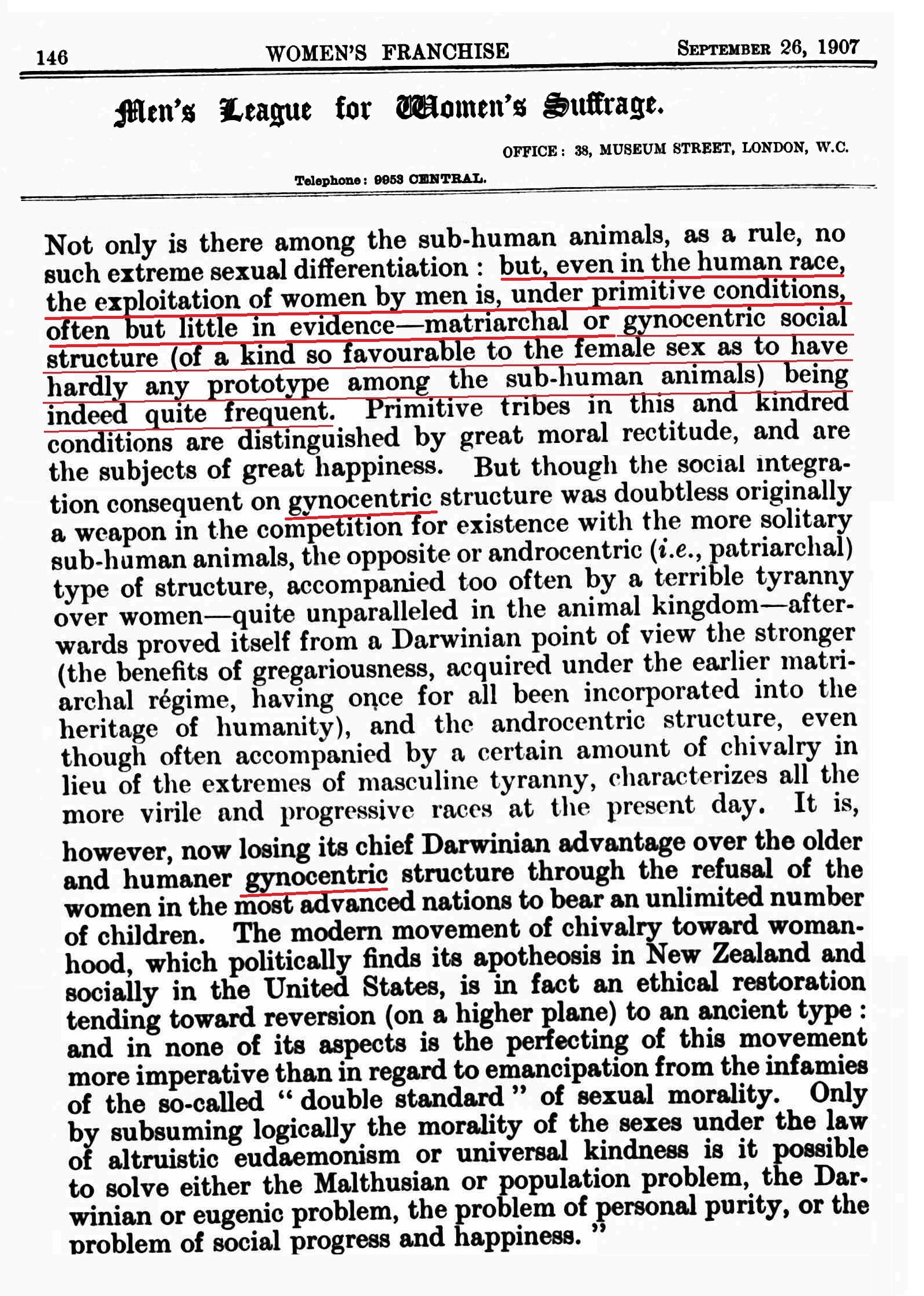
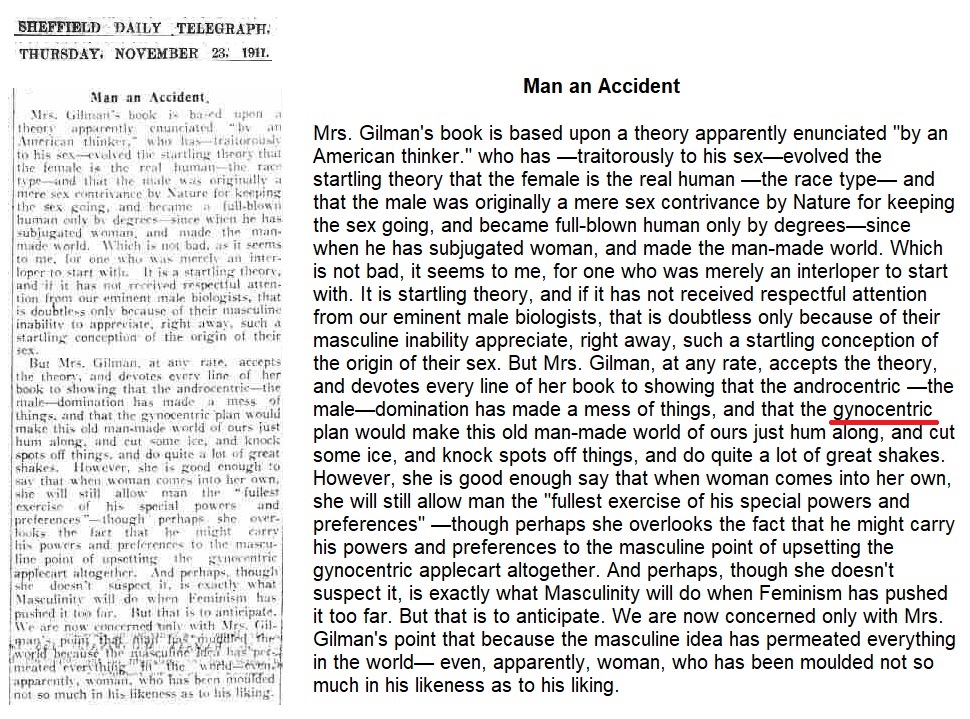
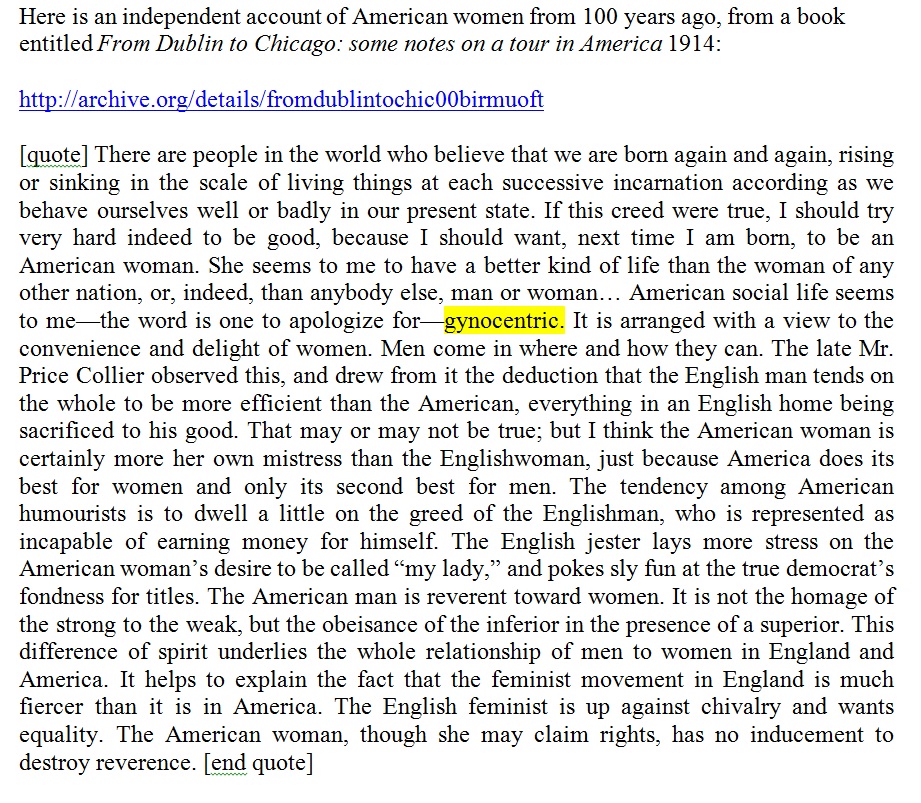
 The origins of the lack of compassion and choice for men is
The origins of the lack of compassion and choice for men is  But gynocentrism runs much deeper than simply being about protecting the borders and doing the dangerous work. It has its tendrils into just about everything, silently and without fanfare. What happens when a woman has a flat tire? How many people have seen the help she will usually garner from men? Now think about what happens if a man has a flat tire. Does he get a similar treatment? Probably not. This is gynocentrism. When there are problems we jump to help women but expect the men to handle it themselves even in today’s atmosphere of “equality”.
But gynocentrism runs much deeper than simply being about protecting the borders and doing the dangerous work. It has its tendrils into just about everything, silently and without fanfare. What happens when a woman has a flat tire? How many people have seen the help she will usually garner from men? Now think about what happens if a man has a flat tire. Does he get a similar treatment? Probably not. This is gynocentrism. When there are problems we jump to help women but expect the men to handle it themselves even in today’s atmosphere of “equality”. Think of that attractive woman being tied to the railroad tracks. What does that do to the hearts and minds of most people? Most of us have an inborn reaction that says DO SOMETHING to help her. But what about a man tied to the tracks? Is your reaction the same or different? Yes, you likely want to see him helped but is it the same gut wrenching sensation? The plots of many movies and novels are fueled by this gynocentric scenario. We all want the woman tied to the tracks safely released even if it means the death of numerous men in the process. A woman’s needs are a call to action while a man’s needs are often just ignored. He needs to save her!
Think of that attractive woman being tied to the railroad tracks. What does that do to the hearts and minds of most people? Most of us have an inborn reaction that says DO SOMETHING to help her. But what about a man tied to the tracks? Is your reaction the same or different? Yes, you likely want to see him helped but is it the same gut wrenching sensation? The plots of many movies and novels are fueled by this gynocentric scenario. We all want the woman tied to the tracks safely released even if it means the death of numerous men in the process. A woman’s needs are a call to action while a man’s needs are often just ignored. He needs to save her! Another example of extreme gynocentrism is boot camp in the army. What is done? The recruit is taught that he is nothing. He is now not an individual, he is a part of a fighting group. His personal identity is deleted and he is taught to fight for the group, for a cause. He no longer exists. There is no compassion for his personal feelings and needs. Those are a distant second. He also has zero choice. He does what he is told. That is the extreme gynocentric model that plays out to one degree or another in our everyday life.
Another example of extreme gynocentrism is boot camp in the army. What is done? The recruit is taught that he is nothing. He is now not an individual, he is a part of a fighting group. His personal identity is deleted and he is taught to fight for the group, for a cause. He no longer exists. There is no compassion for his personal feelings and needs. Those are a distant second. He also has zero choice. He does what he is told. That is the extreme gynocentric model that plays out to one degree or another in our everyday life. One of the best examples of this is the issue of domestic violence where we have known for decades that
One of the best examples of this is the issue of domestic violence where we have known for decades that 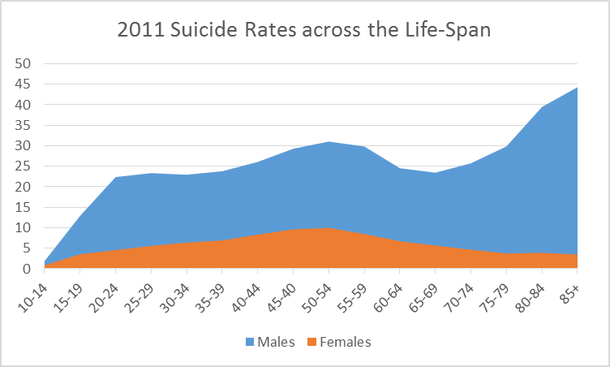 Another example is the issue of suicide
Another example is the issue of suicide  Research is showing that psychological impact of circumcision on boys is similar to the psychological impact for girls who have undergone genital mutilation. This procedure is damaging our boys while most people think it is simple little snip. Wrong. We care about our little girls but fail in mustering enough compassion for boys to shelter them from such barbaric treatment and we give them no choice. Gynocentrism.
Research is showing that psychological impact of circumcision on boys is similar to the psychological impact for girls who have undergone genital mutilation. This procedure is damaging our boys while most people think it is simple little snip. Wrong. We care about our little girls but fail in mustering enough compassion for boys to shelter them from such barbaric treatment and we give them no choice. Gynocentrism.
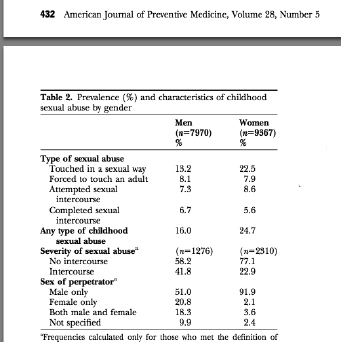 In one study about childhood rape the researchers found that
In one study about childhood rape the researchers found that 
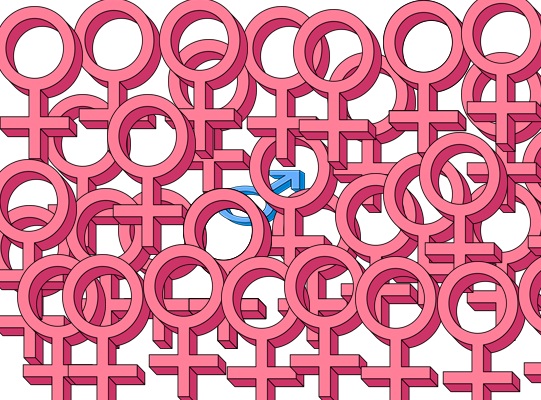 Our focus has been on a larger scale or macro level and it is very easy to see the imbalance in so many spheres. The point here is not that the services that have been created were not a good thing or were undeserved. Many of the services offered have been very helpful to women and girls. The point here is that it has been a very one sided ride with nearly all the services going to women and girls and the men and boys basically ignored. Men and boys have simply not gotten compassion and choice. Gynocentrism 2.0.
Our focus has been on a larger scale or macro level and it is very easy to see the imbalance in so many spheres. The point here is not that the services that have been created were not a good thing or were undeserved. Many of the services offered have been very helpful to women and girls. The point here is that it has been a very one sided ride with nearly all the services going to women and girls and the men and boys basically ignored. Men and boys have simply not gotten compassion and choice. Gynocentrism 2.0.
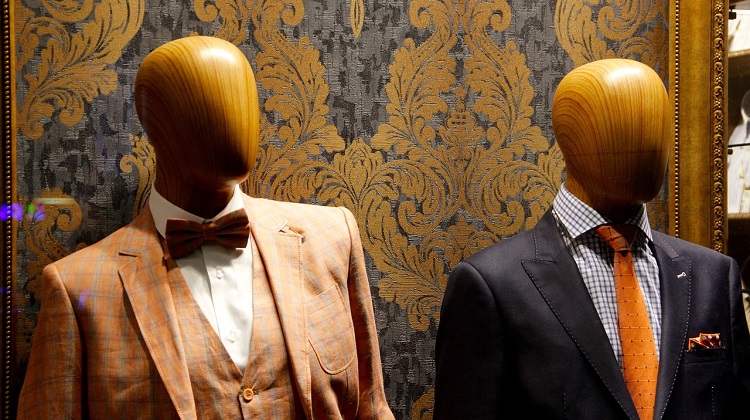
 Por ejemplo, en el caso de los pájaros hembra, prefieren incubar
Por ejemplo, en el caso de los pájaros hembra, prefieren incubar 

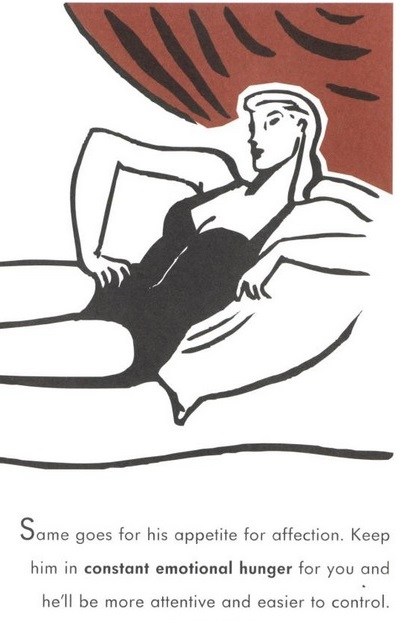 “Un perro siempre se porta mejor cuando quiere que lo alimentes. Después se vuelve un manojo de nervios. Un truco muy conocido para que el perro mantenga su mejor comportamiento consiste en llenar su comedero únicamente hasta la mitad, para que desee más.
“Un perro siempre se porta mejor cuando quiere que lo alimentes. Después se vuelve un manojo de nervios. Un truco muy conocido para que el perro mantenga su mejor comportamiento consiste en llenar su comedero únicamente hasta la mitad, para que desee más.
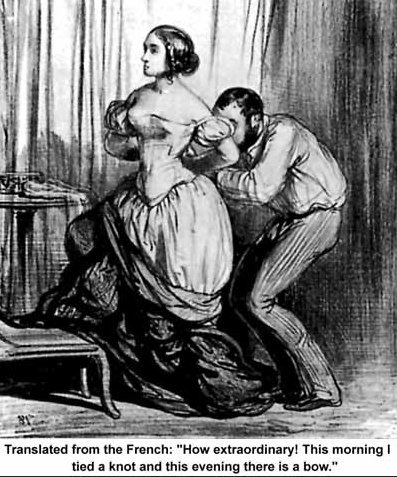
 En resumen, el ginocentrismo extremo en el que vivimos hoy en día es una aberración, un monstruo de Frankenstein que, en cierto modo, no debería existir; por lo menos no más que el gigantesco polluelo de cuco que crece en el nido de un pequeño pinzón. Es un fenómeno para el que nuestros sistemas no están preparados, pero continuamos atrapados en esteciclo de deseo incomprensible que lo mantiene vivo.
En resumen, el ginocentrismo extremo en el que vivimos hoy en día es una aberración, un monstruo de Frankenstein que, en cierto modo, no debería existir; por lo menos no más que el gigantesco polluelo de cuco que crece en el nido de un pequeño pinzón. Es un fenómeno para el que nuestros sistemas no están preparados, pero continuamos atrapados en esteciclo de deseo incomprensible que lo mantiene vivo.